Antibody data
- Antibody Data
- Antigen structure
- References [199]
- Comments [0]
- Validations
- Western blot [1]
- Immunohistochemistry [1]
- Other assay [13]
Submit
Validation data
Reference
Comment
Report error
- Product number
- MA3-925 - Provider product page

- Provider
- Invitrogen Antibodies
- Product name
- RyR1 Monoclonal Antibody (34C)
- Antibody type
- Monoclonal
- Antigen
- Purifed from natural sources
- Description
- MA3-925 detects ryanodine receptor (RyR)-1 and RyR-2 isoforms in amphibian, chicken, bovine, canine, fish, human, non-human primate, mouse, rabbit, mink, rat and sheep tissues. In chickens this antibody detects the alpha, beta and cardiac isoforms. This antibody also detects RyR-3 in mouse cells. In frog, MA3-925 detects the alpha and beta isoforms and in fish it detects the alpha isoform. MA3-925 has been successfully used in Western blot, immunohistochemistry, immunofluorescence and immunoprecipitation procedures. By Western blot, this antibody detects a 565 kDa protein representing RyR from rat skeletal muscle extracts. In non-mammalian vertebrates, a doublet is seen at 565 kDa representing the alpha and beta isoforms of the receptor. Immunohistochemical staining of RyR in chicken brain with MA3-925 results in intense staining of cerebellar Purkinje neurons. The MA3-925 antigen is partially purified chicken pectoral muscle ryanodine receptor.
- Reactivity
- Human, Mouse, Rat, Bovine, Canine, Chicken/Avian, Rabbit
- Host
- Mouse
- Isotype
- IgG
- Antibody clone number
- 34C
- Vial size
- 100 μL
- Concentration
- 1 mg/mL
- Storage
- -20°C, Avoid Freeze/Thaw Cycles
Submitted references Ryanodine receptor RyR1-mediated elevation of Ca(2+) concentration is required for the late stage of myogenic differentiation and fusion.
Septin7 is indispensable for proper skeletal muscle architecture and function.
Essential Role of Somatic Kv2 Channels in High-Frequency Firing in Cartwheel Cells of the Dorsal Cochlear Nucleus.
β(2)-Adrenergic agonist salbutamol augments hypertrophy in MHCIIa fibers and sprint mean power output but not muscle force during 11 weeks of resistance training in young men.
CaMKII inhibition reduces arrhythmogenic Ca2+ events in subendocardial cryoinjured rat living myocardial slices.
Ca2+ release via InsP3Rs enhances RyR recruitment during Ca2+ transients by increasing dyadic [Ca2+] in cardiomyocytes.
Calsequestrins New Calcium Store Markers of Adult Zebrafish Cerebellum and Optic Tectum.
A chronic high-fat diet exacerbates contractile dysfunction with impaired intracellular Ca(2+) release capacity in the skeletal muscle of aged mice.
MG53 suppresses interferon-β and inflammation via regulation of ryanodine receptor-mediated intracellular calcium signaling.
Muscarinic-dependent phosphorylation of the cardiac ryanodine receptor by protein kinase G is mediated by PI3K-AKT-nNOS signaling.
Cardiac hypertrophy and arrhythmia in mice induced by a mutation in ryanodine receptor 2.
A calcium transport mechanism for atrial fibrillation in Tbx5-mutant mice.
Role of type 2A phosphatase regulatory subunit B56α in regulating cardiac responses to β-adrenergic stimulation in vivo.
SERCA2a tyrosine nitration coincides with impairments in maximal SERCA activity in left ventricles from tafazzin-deficient mice.
Electrical Stimulation Prevents Preferential Skeletal Muscle Myosin Loss in Steroid-Denervation Rats.
Remodeling neuronal ER-PM junctions is a conserved nonconducting function of Kv2 plasma membrane ion channels.
Facilitation of ischaemia-induced ventricular fibrillation by catecholamines is mediated by β(1) and β(2) agonism in the rat heart in vitro.
Inositol trisphosphate receptor-mediated Ca2+ signalling stimulates mitochondrial function and gene expression in core myopathy patients.
Sorcin ablation plus β-adrenergic stimulation generate an arrhythmogenic substrate in mouse ventricular myocytes.
Development of the excitation-contraction coupling machinery and its relation to myofibrillogenesis in human iPSC-derived skeletal myocytes.
CPVT-associated cardiac ryanodine receptor mutation G357S with reduced penetrance impairs Ca2+ release termination and diminishes protein expression.
Sarcolipin deletion exacerbates soleus muscle atrophy and weakness in phospholamban overexpressing mice.
Superoxide dismutase/catalase mimetic EUK-134 prevents diaphragm muscle weakness in monocrotalin-induced pulmonary hypertension.
Double-Nanodomain Coupling of Calcium Channels, Ryanodine Receptors, and BK Channels Controls the Generation of Burst Firing.
A chemical chaperone improves muscle function in mice with a RyR1 mutation.
Calcium dysregulation, functional calpainopathy, and endoplasmic reticulum stress in sporadic inclusion body myositis.
Deregulated Ca(2+) cycling underlies the development of arrhythmia and heart disease due to mutant obscurin.
The Arrhythmogenic Calmodulin p.Phe142Leu Mutation Impairs C-domain Ca2+ Binding but Not Calmodulin-dependent Inhibition of the Cardiac Ryanodine Receptor.
Impaired calcium signaling in muscle fibers from intercostal and foot skeletal muscle in a cigarette smoke-induced mouse model of COPD.
Long-term, but not short-term high-fat diet induces fiber composition changes and impaired contractile force in mouse fast-twitch skeletal muscle.
Calcium/calmodulin-dependent kinase II and nitric oxide synthase 1-dependent modulation of ryanodine receptors during β-adrenergic stimulation is restricted to the dyadic cleft.
Enhanced Cytosolic Ca2+ Activation Underlies a Common Defect of Central Domain Cardiac Ryanodine Receptor Mutations Linked to Arrhythmias.
Functional characterization of orbicularis oculi and extraocular muscles.
Hearts deficient in both Mfn1 and Mfn2 are protected against acute myocardial infarction.
Early oxidative damage induced by doxorubicin: Source of production, protection by GKT137831 and effect on Ca(2+) transporters in HL-1 cardiomyocytes.
Role of the JP45-Calsequestrin Complex on Calcium Entry in Slow Twitch Skeletal Muscles.
LRRC10 is required to maintain cardiac function in response to pressure overload.
Characterization of Ca(2+)-Dependent Protein-Protein Interactions within the Ca(2+) Release Units of Cardiac Sarcoplasmic Reticulum.
The maintenance ability and Ca(2+) availability of skeletal muscle are enhanced by sildenafil.
The Cytoplasmic Region of Inner Helix S6 Is an Important Determinant of Cardiac Ryanodine Receptor Channel Gating.
Cannabinoid signalling inhibits sarcoplasmic Ca(2+) release and regulates excitation-contraction coupling in mammalian skeletal muscle.
β-Arrestin-Dependent Dopaminergic Regulation of Calcium Channel Activity in the Axon Initial Segment.
Role of SERCA and the sarcoplasmic reticulum calcium content on calcium waves propagation in rat ventricular myocytes.
Calsequestrins in skeletal and cardiac muscle from adult Danio rerio.
Calpain 3 deficiency affects SERCA expression and function in the skeletal muscle.
Ca(2+) permeation and/or binding to CaV1.1 fine-tunes skeletal muscle Ca(2+) signaling to sustain muscle function.
Intracellular Ca(2+)-handling differs markedly between intact human muscle fibers and myotubes.
Muscle dysfunction associated with adjuvant-induced arthritis is prevented by antioxidant treatment.
Evolutionarily conserved intercalated disc protein Tmem65 regulates cardiac conduction and connexin 43 function.
Ca2+ Binding/Permeation via Calcium Channel, CaV1.1, Regulates the Intracellular Distribution of the Fatty Acid Transport Protein, CD36, and Fatty Acid Metabolism.
Compound RYR1 heterozygosity resulting in a complex phenotype of malignant hyperthermia susceptibility and a core myopathy.
Epigenetic changes as a common trigger of muscle weakness in congenital myopathies.
Sensing Cardiac Electrical Activity With a Cardiac Myocyte--Targeted Optogenetic Voltage Indicator.
Phospholamban overexpression in mice causes a centronuclear myopathy-like phenotype.
Mitsugumin 56 (hedgehog acyltransferase-like) is a sarcoplasmic reticulum-resident protein essential for postnatal muscle maturation.
Sorcin links calcium signaling to vesicle trafficking, regulates Polo-like kinase 1 and is necessary for mitosis.
The role of ryanodine receptor type 3 in a mouse model of Alzheimer disease.
The role of ryanodine receptor type 3 in a mouse model of Alzheimer disease.
A mutation in the CASQ1 gene causes a vacuolar myopathy with accumulation of sarcoplasmic reticulum protein aggregates.
Cell type-specific spatial and functional coupling between mammalian brain Kv2.1 K+ channels and ryanodine receptors.
Suppression of InsP3 receptor-mediated Ca2+ signaling alleviates mutant presenilin-linked familial Alzheimer's disease pathogenesis.
Distinct regions of triadin are required for targeting and retention at the junctional domain of the sarcoplasmic reticulum.
Bcl-2 binds to and inhibits ryanodine receptors.
The ryanodine receptor store-sensing gate controls Ca2+ waves and Ca2+-triggered arrhythmias.
Nuclear BK channels regulate gene expression via the control of nuclear calcium signaling.
A unique ion channel clustering domain on the axon initial segment of mammalian neurons.
Variable myopathic presentation in a single family with novel skeletal RYR1 mutation.
In vivo imaging of intracellular Ca2+ after muscle contractions and direct Ca2+ injection in rat skeletal muscle in diabetes.
Evoked centripetal Ca(2+) mobilization in cardiac Purkinje cells: insight from a model of three Ca(2+) release regions.
Establishment of a human skeletal muscle-derived cell line: biochemical, cellular and electrophysiological characterization.
Deregulation of the protocadherin gene FAT1 alters muscle shapes: implications for the pathogenesis of facioscapulohumeral dystrophy.
Novel excitation-contraction uncoupled RYR1 mutations in patients with central core disease.
Identification of ATP-binding regions in the RyR1 Ca²⁺ release channel.
Tirapazamine-doxorubicin interaction referring to heart oxidative stress and Ca²⁺ balance protein levels.
Expression and localization of ryanodine receptors in the frog semicircular canal.
Abnormalities of calcium handling proteins in skeletal muscle mirror those of the heart in humans with heart failure: a shared mechanism?
Overexpression of histidine-rich calcium binding protein in equine ventricular myocardium.
Decreased cardiac L-type Ca²⁺ channel activity induces hypertrophy and heart failure in mice.
SRP-35, a newly identified protein of the skeletal muscle sarcoplasmic reticulum, is a retinol dehydrogenase.
Dietary nitrate increases tetanic [Ca2+]i and contractile force in mouse fast-twitch muscle.
PI3Ks maintain the structural integrity of T-tubules in cardiac myocytes.
iNOS ablation does not improve specific force of the extensor digitorum longus muscle in dystrophin-deficient mdx4cv mice.
Subcellular heterogeneity of ryanodine receptor properties in ventricular myocytes with low T-tubule density.
Unmasking potential intracellular roles for dysferlin through improved immunolabeling methods.
Integrity of the network sarcoplasmic reticulum in skeletal muscle requires small ankyrin 1.
Antioxidant network expression abrogates oxidative posttranslational modifications in mice.
Identification of novel ryanodine receptor 1 (RyR1) protein interaction with calcium homeostasis endoplasmic reticulum protein (CHERP).
Alterations of excitation-contraction coupling and excitation coupled Ca(2+) entry in human myotubes carrying CAV3 mutations linked to rippling muscle.
Decrease in the density of t-tubular L-type Ca2+ channel currents in failing ventricular myocytes.
Ageing, but not yet senescent, rats exhibit reduced muscle quality and sarcoplasmic reticulum function.
Overexpression of transient receptor potential canonical type 1 (TRPC1) alters both store operated calcium entry and depolarization-evoked calcium signals in C2C12 cells.
Nitrosative stress elicited by nNOSµ delocalization inhibits muscle force in dystrophin-null mice.
Extracellular matrix of collagen modulates intracellular calcium handling and electrophysiological characteristics of HL-1 cardiomyocytes with activation of angiotensin II type 1 receptor.
Discrepant electrophysiological characteristics and calcium homeostasis of left atrial anterior and posterior myocytes.
Enhanced excitation-coupled Ca(2+) entry induces nuclear translocation of NFAT and contributes to IL-6 release from myotubes from patients with central core disease.
Role of presenilin 1 in structural plasticity of cortical dendritic spines in vivo.
Ryanodine receptor oxidation causes intracellular calcium leak and muscle weakness in aging.
Localization of the dantrolene-binding sequence near the FK506-binding protein-binding site in the three-dimensional structure of the ryanodine receptor.
Non-proteolytic functions of calpain-3 in sarcoplasmic reticulum in skeletal muscles.
Total beta-adrenoceptor deficiency results in cardiac hypotrophy and negative inotropy.
Total beta-adrenoceptor deficiency results in cardiac hypotrophy and negative inotropy.
Modulation of Ca(2+) release through ryanodine receptors in vascular smooth muscle by protein kinase Calpha.
Aerobic exercise training improves skeletal muscle function and Ca2+ handling-related protein expression in sympathetic hyperactivity-induced heart failure.
Paclitaxel accelerates spontaneous calcium oscillations in cardiomyocytes by interacting with NCS-1 and the InsP3R.
Ca2+ overload and sarcoplasmic reticulum instability in tric-a null skeletal muscle.
Initiating treadmill training in late middle age offers modest adaptations in Ca2+ handling but enhances oxidative damage in senescent rat skeletal muscle.
Calsequestrin and junctin immunoreactivity in hexagonally cross-linked tubular arrays myopathy.
Role of presenilins in neuronal calcium homeostasis.
Role of CaMKIIdelta phosphorylation of the cardiac ryanodine receptor in the force frequency relationship and heart failure.
Polyol pathway impairs the function of SERCA and RyR in ischemic-reperfused rat hearts by increasing oxidative modifications of these proteins.
Aerobic exercise training improves Ca2+ handling and redox status of skeletal muscle in mice.
Catecholaminergic polymorphic ventricular tachycardia is caused by mutation-linked defective conformational regulation of the ryanodine receptor.
Distribution of ryanodine receptors in rat ventricular myocytes.
Abnormalities in intracellular Ca2+ regulation contribute to the pathomechanism of Tako-Tsubo cardiomyopathy.
Mobilization of calcium from intracellular stores facilitates somatodendritic dopamine release.
Anatomical and neurochemical characterization of dopaminergic interplexiform processes in mouse and rat retinas.
Reduced expression of sarcalumenin and related Ca2+ -regulatory proteins in aged rat skeletal muscle.
Ryanodine receptor phosphorylation at Serine 2030, 2808 and 2814 in rat cardiomyocytes.
Deranged calcium signaling and neurodegeneration in spinocerebellar ataxia type 3.
Sarcoplasmic reticulum Ca2+ release channel ryanodine receptor (RyR2) plays a crucial role in aconitine-induced arrhythmias.
IP3 receptor-dependent Ca2+ release modulates excitation-contraction coupling in rabbit ventricular myocytes.
Nitric oxide regulates growth cone filopodial dynamics via ryanodine receptor-mediated calcium release.
Disruption of the intracellular Ca2+ homeostasis in the cardiac excitation-contraction coupling is a crucial mechanism of arrhythmic toxicity in aconitine-induced cardiomyocytes.
S100A1 decreases calcium spark frequency and alters their spatial characteristics in permeabilized adult ventricular cardiomyocytes.
Functional sarcoplasmic reticulum for calcium handling of human embryonic stem cell-derived cardiomyocytes: insights for driven maturation.
Identification and functional distribution of intracellular ca channels in mouse lacrimal gland acinar cells.
Distribution of inositol-1,4,5-trisphosphate receptor isotypes and ryanodine receptor isotypes during maturation of the rat hippocampus.
Increased phospholamban phosphorylation limits the force-frequency response in the MLP-/- mouse with heart failure.
Effects of congestive heart failure on Ca2+ handling in skeletal muscle during fatigue.
Functional uncoupling between Ca2+ release and afterhyperpolarization in mutant hippocampal neurons lacking junctophilins.
Calcium release from ryanodine receptors in the nucleoplasmic reticulum.
IL-4 inhibits calcium transients in bovine trachealis cells by a ryanodine receptor-dependent mechanism.
Further study on the role of HSP70 on Ca2+ homeostasis in rat ventricular myocytes subjected to simulated ischemia.
Increased sarcoplasmic reticulum calcium leak but unaltered contractility by acute CaMKII overexpression in isolated rabbit cardiac myocytes.
Tumor necrosis factor potentiates central vagal afferent signaling by modulating ryanodine channels.
Ca2+/Calmodulin-dependent protein kinase II phosphorylation of ryanodine receptor does affect calcium sparks in mouse ventricular myocytes.
Expression of the skeletal muscle dystrophin-dystroglycan complex and syntrophin-nitric oxide synthase complex is severely affected in the type 2 diabetic Goto-Kakizaki rat.
The origin of tubular aggregates in human myopathies.
Effects of ryanodine receptor activation on neurotransmitter release and neuronal cell death following kainic acid-induced status epilepticus.
Ca2+ sparks and waves in canine purkinje cells: a triple layered system of Ca2+ activation.
Neuregulin receptor ErbB2 localization at T-tubule in cardiac and skeletal muscle.
S100A1 increases the gain of excitation-contraction coupling in isolated rabbit ventricular cardiomyocytes.
Organic cation permeation through the channel formed by polycystin-2.
Cardiac type 2 inositol 1,4,5-trisphosphate receptor: interaction and modulation by calcium/calmodulin-dependent protein kinase II.
Ca2+ signaling in HEK-293 and skeletal muscle cells expressing recombinant ryanodine receptors harboring malignant hyperthermia and central core disease mutations.
The 12 kDa FK506-binding protein, FKBP12, modulates the Ca(2+)-flux properties of the type-3 ryanodine receptor.
RyR2 and calpain-10 delineate a novel apoptosis pathway in pancreatic islets.
TRPC3 channels confer cellular memory of recent neuromuscular activity.
Cardiac adenoviral S100A1 gene delivery rescues failing myocardium.
Mechanical unloading improves intracellular Ca2+ regulation in rats with doxorubicin-induced cardiomyopathy.
Inhibition of ryanodine receptor 1 in fast skeletal muscle fibers induces a fast-to-slow muscle fiber type transition.
Location of divergent region 2 on the three-dimensional structure of cardiac muscle ryanodine receptor/calcium release channel.
Transgenic overexpression of the Ca2+-binding protein S100A1 in the heart leads to increased in vivo myocardial contractile performance.
S-glutathionylation decreases Mg2+ inhibition and S-nitrosylation enhances Ca2+ activation of RyR1 channels.
Activation of metabotropic glutamate receptor mGlu5 on nuclear membranes mediates intranuclear Ca2+ changes in heterologous cell types and neurons.
Defects in ryanodine receptor calcium release in skeletal muscle from post-myocardial infarct rats.
Use of continuous-elution gel electrophoresis as a preparative tool for blot overlay analysis.
Defective intracellular Ca(2+) signaling contributes to cardiomyopathy in Type 1 diabetic rats.
Abnormal Ca2+ release, but normal ryanodine receptors, in canine and human heart failure.
Isoform-dependent formation of heteromeric Ca2+ release channels (ryanodine receptors).
Ca(2+) signaling in cardiac myocytes overexpressing the alpha(1) subunit of L-type Ca(2+) channel.
Protein kinase A phosphorylation of the ryanodine receptor does not affect calcium sparks in mouse ventricular myocytes.
Cardiac remodeling and atrial fibrillation in transgenic mice overexpressing junctin.
Dynamic localization and clustering of dendritic Kv2.1 voltage-dependent potassium channels in developing hippocampal neurons.
Dynamic localization and clustering of dendritic Kv2.1 voltage-dependent potassium channels in developing hippocampal neurons.
Activation and propagation of Ca(2+) release during excitation-contraction coupling in atrial myocytes.
Three-dimensional reconstruction of the recombinant type 3 ryanodine receptor and localization of its amino terminus.
Contraction and intracellular Ca(2+) handling in isolated skeletal muscle of rats with congestive heart failure.
Contraction and intracellular Ca(2+) handling in isolated skeletal muscle of rats with congestive heart failure.
cADP-ribose/ryanodine channel/Ca2+-release signal transduction pathway in mesangial cells.
cADP-ribose/ryanodine channel/Ca2+-release signal transduction pathway in mesangial cells.
Molecular basis of Ca(2)+ activation of the mouse cardiac Ca(2)+ release channel (ryanodine receptor).
Ca2+-induced Ca2+ release supports the relay mode of activity in thalamocortical cells.
Ca2+-induced Ca2+ release supports the relay mode of activity in thalamocortical cells.
Isometric force and endurance in soleus muscle of thyroid hormone receptor-alpha(1)- or -beta-deficient mice.
Isometric force and endurance in soleus muscle of thyroid hormone receptor-alpha(1)- or -beta-deficient mice.
Identification of a 97-kDa mastoparan-binding protein involving in Ca(2+) release from skeletal muscle sarcoplasmic reticulum.
Presenilin-1 mutations increase levels of ryanodine receptors and calcium release in PC12 cells and cortical neurons.
Long-chain acylcarnitine induces Ca2+ efflux from the sarcoplasmic reticulum.
Long-chain acylcarnitine induces Ca2+ efflux from the sarcoplasmic reticulum.
Enhanced sarcoplasmic reticulum Ca(2+) release following intermittent sprint training.
Enhanced sarcoplasmic reticulum Ca(2+) release following intermittent sprint training.
Translational diffusion of globular proteins in the cytoplasm of cultured muscle cells.
Restoration of diastolic function in senescent rat hearts through adenoviral gene transfer of sarcoplasmic reticulum Ca(2+)-ATPase.
Restoration of diastolic function in senescent rat hearts through adenoviral gene transfer of sarcoplasmic reticulum Ca(2+)-ATPase.
Localization of the cyclic ADP-ribose-dependent calcium signaling pathway in hepatocyte nucleus.
Further characterization of the type 3 ryanodine receptor (RyR3) purified from rabbit diaphragm.
Nitric oxide synthase in cardiac sarcoplasmic reticulum.
Nitric oxide synthase in cardiac sarcoplasmic reticulum.
Skeletal muscle type ryanodine receptor is involved in calcium signaling in human B lymphocytes.
Role of ryanodine receptors in the assembly of calcium release units in skeletal muscle.
Role of ryanodine receptors in the assembly of calcium release units in skeletal muscle.
Cellular distribution of Ca2+ pumps and Ca2+ release channels in rat cardiac hypertrophy induced by aortic stenosis.
Molecular interaction between ryanodine receptor and glycoprotein triadin involves redox cycling of functionally important hyperreactive sulfhydryls.
Positioning of major tryptic fragments in the Ca2+ release channel (ryanodine receptor) resulting from partial digestion of rabbit skeletal muscle sarcoplasmic reticulum.
Three ryanodine receptor isoforms exist in avian striated muscles.
Nonmammalian vertebrate skeletal muscles express two triad junctional foot protein isoforms.
Ryanodine and inositol trisphosphate receptors coexist in avian cerebellar Purkinje neurons.
Identification and localization of two triad junctional foot protein isoforms in mature avian fast twitch skeletal muscle.
Qiu K, Wang Y, Xu D, He L, Zhang X, Yan E, Wang L, Yin J
Journal of animal science and biotechnology 2022 Feb 11;13(1):9
Journal of animal science and biotechnology 2022 Feb 11;13(1):9
Septin7 is indispensable for proper skeletal muscle architecture and function.
Gönczi M, Ráduly Z, Szabó L, Fodor J, Telek A, Dobrosi N, Balogh N, Szentesi P, Kis G, Antal M, Trencsenyi G, Dienes B, Csernoch L
eLife 2022 Aug 5;11
eLife 2022 Aug 5;11
Essential Role of Somatic Kv2 Channels in High-Frequency Firing in Cartwheel Cells of the Dorsal Cochlear Nucleus.
Irie T
eNeuro 2021 May-Jun;8(3)
eNeuro 2021 May-Jun;8(3)
β(2)-Adrenergic agonist salbutamol augments hypertrophy in MHCIIa fibers and sprint mean power output but not muscle force during 11 weeks of resistance training in young men.
Jessen S, Reitelseder S, Kalsen A, Kreiberg M, Onslev J, Gad A, Ørtenblad N, Backer V, Holm L, Bangsbo J, Hostrup M
Journal of applied physiology (Bethesda, Md. : 1985) 2021 Mar 1;130(3):617-626
Journal of applied physiology (Bethesda, Md. : 1985) 2021 Mar 1;130(3):617-626
CaMKII inhibition reduces arrhythmogenic Ca2+ events in subendocardial cryoinjured rat living myocardial slices.
Dries E, Bardi I, Nunez-Toldra R, Meijlink B, Terracciano CM
The Journal of general physiology 2021 Jun 7;153(6)
The Journal of general physiology 2021 Jun 7;153(6)
Ca2+ release via InsP3Rs enhances RyR recruitment during Ca2+ transients by increasing dyadic [Ca2+] in cardiomyocytes.
Demydenko K, Sipido KR, Roderick HL
Journal of cell science 2021 Jul 15;134(14)
Journal of cell science 2021 Jul 15;134(14)
Calsequestrins New Calcium Store Markers of Adult Zebrafish Cerebellum and Optic Tectum.
Furlan S, Campione M, Murgia M, Mosole S, Argenton F, Volpe P, Nori A
Frontiers in neuroanatomy 2020;14:15
Frontiers in neuroanatomy 2020;14:15
A chronic high-fat diet exacerbates contractile dysfunction with impaired intracellular Ca(2+) release capacity in the skeletal muscle of aged mice.
Eshima H, Tamura Y, Kakehi S, Kakigi R, Hashimoto R, Funai K, Kawamori R, Watada H
Journal of applied physiology (Bethesda, Md. : 1985) 2020 May 1;128(5):1153-1162
Journal of applied physiology (Bethesda, Md. : 1985) 2020 May 1;128(5):1153-1162
MG53 suppresses interferon-β and inflammation via regulation of ryanodine receptor-mediated intracellular calcium signaling.
Sermersheim M, Kenney AD, Lin PH, McMichael TM, Cai C, Gumpper K, Adesanya TMA, Li H, Zhou X, Park KH, Yount JS, Ma J
Nature communications 2020 Jul 17;11(1):3624
Nature communications 2020 Jul 17;11(1):3624
Muscarinic-dependent phosphorylation of the cardiac ryanodine receptor by protein kinase G is mediated by PI3K-AKT-nNOS signaling.
Baine S, Thomas J, Bonilla I, Ivanova M, Belevych A, Li J, Veeraraghavan R, Radwanski PB, Carnes C, Gyorke S
The Journal of biological chemistry 2020 Aug 14;295(33):11720-11728
The Journal of biological chemistry 2020 Aug 14;295(33):11720-11728
Cardiac hypertrophy and arrhythmia in mice induced by a mutation in ryanodine receptor 2.
Alvarado FJ, Bos JM, Yuchi Z, Valdivia CR, Hernández JJ, Zhao YT, Henderlong DS, Chen Y, Booher TR, Marcou CA, Van Petegem F, Ackerman MJ, Valdivia HH
JCI insight 2019 Mar 5;5(7)
JCI insight 2019 Mar 5;5(7)
A calcium transport mechanism for atrial fibrillation in Tbx5-mutant mice.
Dai W, Laforest B, Tyan L, Shen KM, Nadadur RD, Alvarado FJ, Mazurek SR, Lazarevic S, Gadek M, Wang Y, Li Y, Valdivia HH, Shen L, Broman MT, Moskowitz IP, Weber CR
eLife 2019 Mar 21;8
eLife 2019 Mar 21;8
Role of type 2A phosphatase regulatory subunit B56α in regulating cardiac responses to β-adrenergic stimulation in vivo.
Puhl SL, Weeks KL, Güran A, Ranieri A, Boknik P, Kirchhefer U, Müller FU, Avkiran M
Cardiovascular research 2019 Mar 1;115(3):519-529
Cardiovascular research 2019 Mar 1;115(3):519-529
SERCA2a tyrosine nitration coincides with impairments in maximal SERCA activity in left ventricles from tafazzin-deficient mice.
Braun JL, Hamstra SI, Messner HN, Fajardo VA
Physiological reports 2019 Aug;7(16):e14215
Physiological reports 2019 Aug;7(16):e14215
Electrical Stimulation Prevents Preferential Skeletal Muscle Myosin Loss in Steroid-Denervation Rats.
Yamada T, Himori K, Tatebayashi D, Yamada R, Ashida Y, Imai T, Akatsuka M, Masuda Y, Kanzaki K, Watanabe D, Wada M, Westerblad H, Lanner JT
Frontiers in physiology 2018;9:1111
Frontiers in physiology 2018;9:1111
Remodeling neuronal ER-PM junctions is a conserved nonconducting function of Kv2 plasma membrane ion channels.
Kirmiz M, Palacio S, Thapa P, King AN, Sack JT, Trimmer JS
Molecular biology of the cell 2018 Oct 1;29(20):2410-2432
Molecular biology of the cell 2018 Oct 1;29(20):2410-2432
Facilitation of ischaemia-induced ventricular fibrillation by catecholamines is mediated by β(1) and β(2) agonism in the rat heart in vitro.
Wilder CDE, Pavlaki N, Dursun T, Gyimah P, Caldwell-Dunn E, Ranieri A, Lewis HR, Curtis MJ
British journal of pharmacology 2018 May;175(10):1669-1690
British journal of pharmacology 2018 May;175(10):1669-1690
Inositol trisphosphate receptor-mediated Ca2+ signalling stimulates mitochondrial function and gene expression in core myopathy patients.
Suman M, Sharpe JA, Bentham RB, Kotiadis VN, Menegollo M, Pignataro V, Molgó J, Muntoni F, Duchen MR, Pegoraro E, Szabadkai G
Human molecular genetics 2018 Jul 1;27(13):2367-2382
Human molecular genetics 2018 Jul 1;27(13):2367-2382
Sorcin ablation plus β-adrenergic stimulation generate an arrhythmogenic substrate in mouse ventricular myocytes.
Chen X, Weber C, Farrell ET, Alvarado FJ, Zhao YT, Gómez AM, Valdivia HH
Journal of molecular and cellular cardiology 2018 Jan;114:199-210
Journal of molecular and cellular cardiology 2018 Jan;114:199-210
Development of the excitation-contraction coupling machinery and its relation to myofibrillogenesis in human iPSC-derived skeletal myocytes.
Lainé J, Skoglund G, Fournier E, Tabti N
Skeletal muscle 2018 Jan 5;8(1):1
Skeletal muscle 2018 Jan 5;8(1):1
CPVT-associated cardiac ryanodine receptor mutation G357S with reduced penetrance impairs Ca2+ release termination and diminishes protein expression.
Liu Y, Wei J, Wong King Yuen SM, Sun B, Tang Y, Wang R, Van Petegem F, Chen SRW
PloS one 2017;12(9):e0184177
PloS one 2017;12(9):e0184177
Sarcolipin deletion exacerbates soleus muscle atrophy and weakness in phospholamban overexpressing mice.
Fajardo VA, Gamu D, Mitchell A, Bloemberg D, Bombardier E, Chambers PJ, Bellissimo C, Quadrilatero J, Tupling AR
PloS one 2017;12(3):e0173708
PloS one 2017;12(3):e0173708
Superoxide dismutase/catalase mimetic EUK-134 prevents diaphragm muscle weakness in monocrotalin-induced pulmonary hypertension.
Himori K, Abe M, Tatebayashi D, Lee J, Westerblad H, Lanner JT, Yamada T
PloS one 2017;12(2):e0169146
PloS one 2017;12(2):e0169146
Double-Nanodomain Coupling of Calcium Channels, Ryanodine Receptors, and BK Channels Controls the Generation of Burst Firing.
Irie T, Trussell LO
Neuron 2017 Nov 15;96(4):856-870.e4
Neuron 2017 Nov 15;96(4):856-870.e4
A chemical chaperone improves muscle function in mice with a RyR1 mutation.
Lee CS, Hanna AD, Wang H, Dagnino-Acosta A, Joshi AD, Knoblauch M, Xia Y, Georgiou DK, Xu J, Long C, Amano H, Reynolds C, Dong K, Martin JC, Lagor WR, Rodney GG, Sahin E, Sewry C, Hamilton SL
Nature communications 2017 Mar 24;8:14659
Nature communications 2017 Mar 24;8:14659
Calcium dysregulation, functional calpainopathy, and endoplasmic reticulum stress in sporadic inclusion body myositis.
Amici DR, Pinal-Fernandez I, Mázala DA, Lloyd TE, Corse AM, Christopher-Stine L, Mammen AL, Chin ER
Acta neuropathologica communications 2017 Mar 22;5(1):24
Acta neuropathologica communications 2017 Mar 22;5(1):24
Deregulated Ca(2+) cycling underlies the development of arrhythmia and heart disease due to mutant obscurin.
Hu LR, Ackermann MA, Hecker PA, Prosser BL, King B, O'Connell KA, Grogan A, Meyer LC, Berndsen CE, Wright NT, Jonathan Lederer W, Kontrogianni-Konstantopoulos A
Science advances 2017 Jun;3(6):e1603081
Science advances 2017 Jun;3(6):e1603081
The Arrhythmogenic Calmodulin p.Phe142Leu Mutation Impairs C-domain Ca2+ Binding but Not Calmodulin-dependent Inhibition of the Cardiac Ryanodine Receptor.
Søndergaard MT, Liu Y, Larsen KT, Nani A, Tian X, Holt C, Wang R, Wimmer R, Van Petegem F, Fill M, Chen SR, Overgaard MT
The Journal of biological chemistry 2017 Jan 27;292(4):1385-1395
The Journal of biological chemistry 2017 Jan 27;292(4):1385-1395
Impaired calcium signaling in muscle fibers from intercostal and foot skeletal muscle in a cigarette smoke-induced mouse model of COPD.
Robison P, Sussan TE, Chen H, Biswal S, Schneider MF, Hernández-Ochoa EO
Muscle & nerve 2017 Aug;56(2):282-291
Muscle & nerve 2017 Aug;56(2):282-291
Long-term, but not short-term high-fat diet induces fiber composition changes and impaired contractile force in mouse fast-twitch skeletal muscle.
Eshima H, Tamura Y, Kakehi S, Kurebayashi N, Murayama T, Nakamura K, Kakigi R, Okada T, Sakurai T, Kawamori R, Watada H
Physiological reports 2017 Apr;5(7)
Physiological reports 2017 Apr;5(7)
Calcium/calmodulin-dependent kinase II and nitric oxide synthase 1-dependent modulation of ryanodine receptors during β-adrenergic stimulation is restricted to the dyadic cleft.
Dries E, Santiago DJ, Johnson DM, Gilbert G, Holemans P, Korte SM, Roderick HL, Sipido KR
The Journal of physiology 2016 Oct 15;594(20):5923-5939
The Journal of physiology 2016 Oct 15;594(20):5923-5939
Enhanced Cytosolic Ca2+ Activation Underlies a Common Defect of Central Domain Cardiac Ryanodine Receptor Mutations Linked to Arrhythmias.
Xiao Z, Guo W, Sun B, Hunt DJ, Wei J, Liu Y, Wang Y, Wang R, Jones PP, Back TG, Chen SRW
The Journal of biological chemistry 2016 Nov 18;291(47):24528-24537
The Journal of biological chemistry 2016 Nov 18;291(47):24528-24537
Functional characterization of orbicularis oculi and extraocular muscles.
Sekulic-Jablanovic M, Ullrich ND, Goldblum D, Palmowski-Wolfe A, Zorzato F, Treves S
The Journal of general physiology 2016 May;147(5):395-406
The Journal of general physiology 2016 May;147(5):395-406
Hearts deficient in both Mfn1 and Mfn2 are protected against acute myocardial infarction.
Hall AR, Burke N, Dongworth RK, Kalkhoran SB, Dyson A, Vicencio JM, Dorn GW II, Yellon DM, Hausenloy DJ
Cell death & disease 2016 May 26;7(5):e2238
Cell death & disease 2016 May 26;7(5):e2238
Early oxidative damage induced by doxorubicin: Source of production, protection by GKT137831 and effect on Ca(2+) transporters in HL-1 cardiomyocytes.
Asensio-López MC, Soler F, Sánchez-Más J, Pascual-Figal D, Fernández-Belda F, Lax A
Archives of biochemistry and biophysics 2016 Mar 15;594:26-36
Archives of biochemistry and biophysics 2016 Mar 15;594:26-36
Role of the JP45-Calsequestrin Complex on Calcium Entry in Slow Twitch Skeletal Muscles.
Mosca B, Eckhardt J, Bergamelli L, Treves S, Bongianino R, De Negri M, Priori SG, Protasi F, Zorzato F
The Journal of biological chemistry 2016 Jul 8;291(28):14555-65
The Journal of biological chemistry 2016 Jul 8;291(28):14555-65
LRRC10 is required to maintain cardiac function in response to pressure overload.
Brody MJ, Feng L, Grimes AC, Hacker TA, Olson TM, Kamp TJ, Balijepalli RC, Lee Y
American journal of physiology. Heart and circulatory physiology 2016 Jan 15;310(2):H269-78
American journal of physiology. Heart and circulatory physiology 2016 Jan 15;310(2):H269-78
Characterization of Ca(2+)-Dependent Protein-Protein Interactions within the Ca(2+) Release Units of Cardiac Sarcoplasmic Reticulum.
Rani S, Park CS, Sreenivasaiah PK, Kim DH
Molecules and cells 2016 Feb;39(2):149-55
Molecules and cells 2016 Feb;39(2):149-55
The maintenance ability and Ca(2+) availability of skeletal muscle are enhanced by sildenafil.
Huang M, Lee KJ, Kim KJ, Ahn MK, Cho CH, Kim DH, Lee EH
Experimental & molecular medicine 2016 Dec 9;48(12):e278
Experimental & molecular medicine 2016 Dec 9;48(12):e278
The Cytoplasmic Region of Inner Helix S6 Is an Important Determinant of Cardiac Ryanodine Receptor Channel Gating.
Sun B, Guo W, Tian X, Yao J, Zhang L, Wang R, Chen SR
The Journal of biological chemistry 2016 Dec 9;291(50):26024-26034
The Journal of biological chemistry 2016 Dec 9;291(50):26024-26034
Cannabinoid signalling inhibits sarcoplasmic Ca(2+) release and regulates excitation-contraction coupling in mammalian skeletal muscle.
Oláh T, Bodnár D, Tóth A, Vincze J, Fodor J, Reischl B, Kovács A, Ruzsnavszky O, Dienes B, Szentesi P, Friedrich O, Csernoch L
The Journal of physiology 2016 Dec 15;594(24):7381-7398
The Journal of physiology 2016 Dec 15;594(24):7381-7398
β-Arrestin-Dependent Dopaminergic Regulation of Calcium Channel Activity in the Axon Initial Segment.
Yang S, Ben-Shalom R, Ahn M, Liptak AT, van Rijn RM, Whistler JL, Bender KJ
Cell reports 2016 Aug 9;16(6):1518-1526
Cell reports 2016 Aug 9;16(6):1518-1526
Role of SERCA and the sarcoplasmic reticulum calcium content on calcium waves propagation in rat ventricular myocytes.
Salazar-Cantú A, Pérez-Treviño P, Montalvo-Parra D, Balderas-Villalobos J, Gómez-Víquez NL, García N, Altamirano J
Archives of biochemistry and biophysics 2016 Aug 15;604:11-9
Archives of biochemistry and biophysics 2016 Aug 15;604:11-9
Calsequestrins in skeletal and cardiac muscle from adult Danio rerio.
Furlan S, Mosole S, Murgia M, Nagaraj N, Argenton F, Volpe P, Nori A
Journal of muscle research and cell motility 2016 Apr;37(1-2):27-39
Journal of muscle research and cell motility 2016 Apr;37(1-2):27-39
Calpain 3 deficiency affects SERCA expression and function in the skeletal muscle.
Toral-Ojeda I, Aldanondo G, Lasa-Elgarresta J, Lasa-Fernández H, Fernández-Torrón R, López de Munain A, Vallejo-Illarramendi A
Expert reviews in molecular medicine 2016 Apr 8;18:e7
Expert reviews in molecular medicine 2016 Apr 8;18:e7
Ca(2+) permeation and/or binding to CaV1.1 fine-tunes skeletal muscle Ca(2+) signaling to sustain muscle function.
Lee CS, Dagnino-Acosta A, Yarotskyy V, Hanna A, Lyfenko A, Knoblauch M, Georgiou DK, Poché RA, Swank MW, Long C, Ismailov II, Lanner J, Tran T, Dong K, Rodney GG, Dickinson ME, Beeton C, Zhang P, Dirksen RT, Hamilton SL
Skeletal muscle 2015;5:4
Skeletal muscle 2015;5:4
Intracellular Ca(2+)-handling differs markedly between intact human muscle fibers and myotubes.
Olsson K, Cheng AJ, Alam S, Al-Ameri M, Rullman E, Westerblad H, Lanner JT, Bruton JD, Gustafsson T
Skeletal muscle 2015;5:26
Skeletal muscle 2015;5:26
Muscle dysfunction associated with adjuvant-induced arthritis is prevented by antioxidant treatment.
Yamada T, Abe M, Lee J, Tatebayashi D, Himori K, Kanzaki K, Wada M, Bruton JD, Westerblad H, Lanner JT
Skeletal muscle 2015;5:20
Skeletal muscle 2015;5:20
Evolutionarily conserved intercalated disc protein Tmem65 regulates cardiac conduction and connexin 43 function.
Sharma P, Abbasi C, Lazic S, Teng ACT, Wang D, Dubois N, Ignatchenko V, Wong V, Liu J, Araki T, Tiburcy M, Ackerley C, Zimmermann WH, Hamilton R, Sun Y, Liu PP, Keller G, Stagljar I, Scott IC, Kislinger T, Gramolini AO
Nature communications 2015 Sep 25;6:8391
Nature communications 2015 Sep 25;6:8391
Ca2+ Binding/Permeation via Calcium Channel, CaV1.1, Regulates the Intracellular Distribution of the Fatty Acid Transport Protein, CD36, and Fatty Acid Metabolism.
Georgiou DK, Dagnino-Acosta A, Lee CS, Griffin DM, Wang H, Lagor WR, Pautler RG, Dirksen RT, Hamilton SL
The Journal of biological chemistry 2015 Sep 25;290(39):23751-65
The Journal of biological chemistry 2015 Sep 25;290(39):23751-65
Compound RYR1 heterozygosity resulting in a complex phenotype of malignant hyperthermia susceptibility and a core myopathy.
Kraeva N, Heytens L, Jungbluth H, Treves S, Voermans N, Kamsteeg E, Ceuterick-de Groote C, Baets J, Riazi S
Neuromuscular disorders : NMD 2015 Jul;25(7):567-76
Neuromuscular disorders : NMD 2015 Jul;25(7):567-76
Epigenetic changes as a common trigger of muscle weakness in congenital myopathies.
Rokach O, Sekulic-Jablanovic M, Voermans N, Wilmshurst J, Pillay K, Heytens L, Zhou H, Muntoni F, Gautel M, Nevo Y, Mitrani-Rosenbaum S, Attali R, Finotti A, Gambari R, Mosca B, Jungbluth H, Zorzato F, Treves S
Human molecular genetics 2015 Aug 15;24(16):4636-47
Human molecular genetics 2015 Aug 15;24(16):4636-47
Sensing Cardiac Electrical Activity With a Cardiac Myocyte--Targeted Optogenetic Voltage Indicator.
Chang Liao ML, de Boer TP, Mutoh H, Raad N, Richter C, Wagner E, Downie BR, Unsöld B, Arooj I, Streckfuss-Bömeke K, Döker S, Luther S, Guan K, Wagner S, Lehnart SE, Maier LS, Stühmer W, Wettwer E, van Veen T, Morlock MM, Knöpfel T, Zimmermann WH
Circulation research 2015 Aug 14;117(5):401-12
Circulation research 2015 Aug 14;117(5):401-12
Phospholamban overexpression in mice causes a centronuclear myopathy-like phenotype.
Fajardo VA, Bombardier E, McMillan E, Tran K, Wadsworth BJ, Gamu D, Hopf A, Vigna C, Smith IC, Bellissimo C, Michel RN, Tarnopolsky MA, Quadrilatero J, Tupling AR
Disease models & mechanisms 2015 Aug 1;8(8):999-1009
Disease models & mechanisms 2015 Aug 1;8(8):999-1009
Mitsugumin 56 (hedgehog acyltransferase-like) is a sarcoplasmic reticulum-resident protein essential for postnatal muscle maturation.
Van B, Nishi M, Komazaki S, Ichimura A, Kakizawa S, Nakanaga K, Aoki J, Park KH, Ma J, Ueyama T, Ogata T, Maruyama N, Takeshima H
FEBS letters 2015 Apr 28;589(10):1095-104
FEBS letters 2015 Apr 28;589(10):1095-104
Sorcin links calcium signaling to vesicle trafficking, regulates Polo-like kinase 1 and is necessary for mitosis.
Lalioti VS, Ilari A, O'Connell DJ, Poser E, Sandoval IV, Colotti G
PloS one 2014;9(1):e85438
PloS one 2014;9(1):e85438
The role of ryanodine receptor type 3 in a mouse model of Alzheimer disease.
Liu J, Supnet C, Sun S, Zhang H, Good L, Popugaeva E, Bezprozvanny I
Channels (Austin, Tex.) 2014;8(3):230-42
Channels (Austin, Tex.) 2014;8(3):230-42
The role of ryanodine receptor type 3 in a mouse model of Alzheimer disease.
Liu J, Supnet C, Sun S, Zhang H, Good L, Popugaeva E, Bezprozvanny I
Channels (Austin, Tex.) 2014;8(3):230-42
Channels (Austin, Tex.) 2014;8(3):230-42
A mutation in the CASQ1 gene causes a vacuolar myopathy with accumulation of sarcoplasmic reticulum protein aggregates.
Rossi D, Vezzani B, Galli L, Paolini C, Toniolo L, Pierantozzi E, Spinozzi S, Barone V, Pegoraro E, Bello L, Cenacchi G, Vattemi G, Tomelleri G, Ricci G, Siciliano G, Protasi F, Reggiani C, Sorrentino V
Human mutation 2014 Oct;35(10):1163-70
Human mutation 2014 Oct;35(10):1163-70
Cell type-specific spatial and functional coupling between mammalian brain Kv2.1 K+ channels and ryanodine receptors.
Mandikian D, Bocksteins E, Parajuli LK, Bishop HI, Cerda O, Shigemoto R, Trimmer JS
The Journal of comparative neurology 2014 Oct 15;522(15):3555-74
The Journal of comparative neurology 2014 Oct 15;522(15):3555-74
Suppression of InsP3 receptor-mediated Ca2+ signaling alleviates mutant presenilin-linked familial Alzheimer's disease pathogenesis.
Shilling D, Müller M, Takano H, Mak DO, Abel T, Coulter DA, Foskett JK
The Journal of neuroscience : the official journal of the Society for Neuroscience 2014 May 14;34(20):6910-23
The Journal of neuroscience : the official journal of the Society for Neuroscience 2014 May 14;34(20):6910-23
Distinct regions of triadin are required for targeting and retention at the junctional domain of the sarcoplasmic reticulum.
Rossi D, Bencini C, Maritati M, Benini F, Lorenzini S, Pierantozzi E, Scarcella AM, Paolini C, Protasi F, Sorrentino V
The Biochemical journal 2014 Mar 1;458(2):407-17
The Biochemical journal 2014 Mar 1;458(2):407-17
Bcl-2 binds to and inhibits ryanodine receptors.
Vervliet T, Decrock E, Molgó J, Sorrentino V, Missiaen L, Leybaert L, De Smedt H, Kasri NN, Parys JB, Bultynck G
Journal of cell science 2014 Jun 15;127(Pt 12):2782-92
Journal of cell science 2014 Jun 15;127(Pt 12):2782-92
The ryanodine receptor store-sensing gate controls Ca2+ waves and Ca2+-triggered arrhythmias.
Chen W, Wang R, Chen B, Zhong X, Kong H, Bai Y, Zhou Q, Xie C, Zhang J, Guo A, Tian X, Jones PP, O'Mara ML, Liu Y, Mi T, Zhang L, Bolstad J, Semeniuk L, Cheng H, Zhang J, Chen J, Tieleman DP, Gillis AM, Duff HJ, Fill M, Song LS, Chen SR
Nature medicine 2014 Feb;20(2):184-92
Nature medicine 2014 Feb;20(2):184-92
Nuclear BK channels regulate gene expression via the control of nuclear calcium signaling.
Li B, Jie W, Huang L, Wei P, Li S, Luo Z, Friedman AK, Meredith AL, Han MH, Zhu XH, Gao TM
Nature neuroscience 2014 Aug;17(8):1055-63
Nature neuroscience 2014 Aug;17(8):1055-63
A unique ion channel clustering domain on the axon initial segment of mammalian neurons.
King AN, Manning CF, Trimmer JS
The Journal of comparative neurology 2014 Aug 1;522(11):2594-608
The Journal of comparative neurology 2014 Aug 1;522(11):2594-608
Variable myopathic presentation in a single family with novel skeletal RYR1 mutation.
Attali R, Aharoni S, Treves S, Rokach O, Becker Cohen M, Fellig Y, Straussberg R, Dor T, Daana M, Mitrani-Rosenbaum S, Nevo Y
PloS one 2013;8(7):e69296
PloS one 2013;8(7):e69296
In vivo imaging of intracellular Ca2+ after muscle contractions and direct Ca2+ injection in rat skeletal muscle in diabetes.
Eshima H, Tanaka Y, Sonobe T, Inagaki T, Nakajima T, Poole DC, Kano Y
American journal of physiology. Regulatory, integrative and comparative physiology 2013 Sep 15;305(6):R610-8
American journal of physiology. Regulatory, integrative and comparative physiology 2013 Sep 15;305(6):R610-8
Evoked centripetal Ca(2+) mobilization in cardiac Purkinje cells: insight from a model of three Ca(2+) release regions.
Haq KT, Daniels RE, Miller LS, Miura M, ter Keurs HE, Bungay SD, Stuyvers BD
The Journal of physiology 2013 Sep 1;591(17):4301-19
The Journal of physiology 2013 Sep 1;591(17):4301-19
Establishment of a human skeletal muscle-derived cell line: biochemical, cellular and electrophysiological characterization.
Rokach O, Ullrich ND, Rausch M, Mouly V, Zhou H, Muntoni F, Zorzato F, Treves S
The Biochemical journal 2013 Oct 15;455(2):169-77
The Biochemical journal 2013 Oct 15;455(2):169-77
Deregulation of the protocadherin gene FAT1 alters muscle shapes: implications for the pathogenesis of facioscapulohumeral dystrophy.
Caruso N, Herberth B, Bartoli M, Puppo F, Dumonceaux J, Zimmermann A, Denadai S, Lebossé M, Roche S, Geng L, Magdinier F, Attarian S, Bernard R, Maina F, Levy N, Helmbacher F
PLoS genetics 2013 Jun;9(6):e1003550
PLoS genetics 2013 Jun;9(6):e1003550
Novel excitation-contraction uncoupled RYR1 mutations in patients with central core disease.
Kraeva N, Zvaritch E, Rossi AE, Goonasekera SA, Zaid H, Frodis W, Kraev A, Dirksen RT, Maclennan DH, Riazi S
Neuromuscular disorders : NMD 2013 Feb;23(2):120-32
Neuromuscular disorders : NMD 2013 Feb;23(2):120-32
Identification of ATP-binding regions in the RyR1 Ca²⁺ release channel.
Popova OB, Baker MR, Tran TP, Le T, Serysheva II
PloS one 2012;7(11):e48725
PloS one 2012;7(11):e48725
Tirapazamine-doxorubicin interaction referring to heart oxidative stress and Ca²⁺ balance protein levels.
Sliwinska J, Dudka J, Korga A, Burdan F, Matysiak W, Jodlowska-Jedrych B, Mandziuk S, Dawidek-Pietryka K
Oxidative medicine and cellular longevity 2012;2012:890826
Oxidative medicine and cellular longevity 2012;2012:890826
Expression and localization of ryanodine receptors in the frog semicircular canal.
Perin P, Botta L, Tritto S, Laforenza U
Journal of biomedicine & biotechnology 2012;2012:398398
Journal of biomedicine & biotechnology 2012;2012:398398
Abnormalities of calcium handling proteins in skeletal muscle mirror those of the heart in humans with heart failure: a shared mechanism?
Middlekauff HR, Vigna C, Verity MA, Fonarow GC, Horwich TB, Hamilton MA, Shieh P, Tupling AR
Journal of cardiac failure 2012 Sep;18(9):724-33
Journal of cardiac failure 2012 Sep;18(9):724-33
Overexpression of histidine-rich calcium binding protein in equine ventricular myocardium.
Sacchetto R, Sharova E, Patruno M, Maccatrozzo L, Damiani E, Mascarello F
Veterinary journal (London, England : 1997) 2012 Jul;193(1):157-61
Veterinary journal (London, England : 1997) 2012 Jul;193(1):157-61
Decreased cardiac L-type Ca²⁺ channel activity induces hypertrophy and heart failure in mice.
Goonasekera SA, Hammer K, Auger-Messier M, Bodi I, Chen X, Zhang H, Reiken S, Elrod JW, Correll RN, York AJ, Sargent MA, Hofmann F, Moosmang S, Marks AR, Houser SR, Bers DM, Molkentin JD
The Journal of clinical investigation 2012 Jan;122(1):280-90
The Journal of clinical investigation 2012 Jan;122(1):280-90
SRP-35, a newly identified protein of the skeletal muscle sarcoplasmic reticulum, is a retinol dehydrogenase.
Treves S, Thurnheer R, Mosca B, Vukcevic M, Bergamelli L, Voltan R, Oberhauser V, Ronjat M, Csernoch L, Szentesi P, Zorzato F
The Biochemical journal 2012 Jan 15;441(2):731-41
The Biochemical journal 2012 Jan 15;441(2):731-41
Dietary nitrate increases tetanic [Ca2+]i and contractile force in mouse fast-twitch muscle.
Hernández A, Schiffer TA, Ivarsson N, Cheng AJ, Bruton JD, Lundberg JO, Weitzberg E, Westerblad H
The Journal of physiology 2012 Aug 1;590(15):3575-83
The Journal of physiology 2012 Aug 1;590(15):3575-83
PI3Ks maintain the structural integrity of T-tubules in cardiac myocytes.
Wu CY, Jia Z, Wang W, Ballou LM, Jiang YP, Chen B, Mathias RT, Cohen IS, Song LS, Entcheva E, Lin RZ
PloS one 2011;6(9):e24404
PloS one 2011;6(9):e24404
iNOS ablation does not improve specific force of the extensor digitorum longus muscle in dystrophin-deficient mdx4cv mice.
Li D, Shin JH, Duan D
PloS one 2011;6(6):e21618
PloS one 2011;6(6):e21618
Subcellular heterogeneity of ryanodine receptor properties in ventricular myocytes with low T-tubule density.
Biesmans L, Macquaide N, Heinzel FR, Bito V, Smith GL, Sipido KR
PloS one 2011;6(10):e25100
PloS one 2011;6(10):e25100
Unmasking potential intracellular roles for dysferlin through improved immunolabeling methods.
Roche JA, Ru LW, O'Neill AM, Resneck WG, Lovering RM, Bloch RJ
The journal of histochemistry and cytochemistry : official journal of the Histochemistry Society 2011 Nov;59(11):964-75
The journal of histochemistry and cytochemistry : official journal of the Histochemistry Society 2011 Nov;59(11):964-75
Integrity of the network sarcoplasmic reticulum in skeletal muscle requires small ankyrin 1.
Ackermann MA, Ziman AP, Strong J, Zhang Y, Hartford AK, Ward CW, Randall WR, Kontrogianni-Konstantopoulos A, Bloch RJ
Journal of cell science 2011 Nov 1;124(Pt 21):3619-30
Journal of cell science 2011 Nov 1;124(Pt 21):3619-30
Antioxidant network expression abrogates oxidative posttranslational modifications in mice.
Mital R, Zhang W, Cai M, Huttinger ZM, Goodman LA, Wheeler DG, Ziolo MT, Dwyer KM, d'Apice AJ, Zweier JL, He G, Cowan PJ, Gumina RJ
American journal of physiology. Heart and circulatory physiology 2011 May;300(5):H1960-70
American journal of physiology. Heart and circulatory physiology 2011 May;300(5):H1960-70
Identification of novel ryanodine receptor 1 (RyR1) protein interaction with calcium homeostasis endoplasmic reticulum protein (CHERP).
Ryan T, Sharma P, Ignatchenko A, MacLennan DH, Kislinger T, Gramolini AO
The Journal of biological chemistry 2011 May 13;286(19):17060-8
The Journal of biological chemistry 2011 May 13;286(19):17060-8
Alterations of excitation-contraction coupling and excitation coupled Ca(2+) entry in human myotubes carrying CAV3 mutations linked to rippling muscle.
Ullrich ND, Fischer D, Kornblum C, Walter MC, Niggli E, Zorzato F, Treves S
Human mutation 2011 Mar;32(3):309-17
Human mutation 2011 Mar;32(3):309-17
Decrease in the density of t-tubular L-type Ca2+ channel currents in failing ventricular myocytes.
Horiuchi-Hirose M, Kashihara T, Nakada T, Kurebayashi N, Shimojo H, Shibazaki T, Sheng X, Yano S, Hirose M, Hongo M, Sakurai T, Moriizumi T, Ueda H, Yamada M
American journal of physiology. Heart and circulatory physiology 2011 Mar;300(3):H978-88
American journal of physiology. Heart and circulatory physiology 2011 Mar;300(3):H978-88
Ageing, but not yet senescent, rats exhibit reduced muscle quality and sarcoplasmic reticulum function.
Russ DW, Grandy JS, Toma K, Ward CW
Acta physiologica (Oxford, England) 2011 Mar;201(3):391-403
Acta physiologica (Oxford, England) 2011 Mar;201(3):391-403
Overexpression of transient receptor potential canonical type 1 (TRPC1) alters both store operated calcium entry and depolarization-evoked calcium signals in C2C12 cells.
Oláh T, Fodor J, Ruzsnavszky O, Vincze J, Berbey C, Allard B, Csernoch L
Cell calcium 2011 Jun;49(6):415-25
Cell calcium 2011 Jun;49(6):415-25
Nitrosative stress elicited by nNOSµ delocalization inhibits muscle force in dystrophin-null mice.
Li D, Yue Y, Lai Y, Hakim CH, Duan D
The Journal of pathology 2011 Jan;223(1):88-98
The Journal of pathology 2011 Jan;223(1):88-98
Extracellular matrix of collagen modulates intracellular calcium handling and electrophysiological characteristics of HL-1 cardiomyocytes with activation of angiotensin II type 1 receptor.
Lu YY, Chen YC, Kao YH, Wu TJ, Chen SA, Chen YJ
Journal of cardiac failure 2011 Jan;17(1):82-90
Journal of cardiac failure 2011 Jan;17(1):82-90
Discrepant electrophysiological characteristics and calcium homeostasis of left atrial anterior and posterior myocytes.
Suenari K, Chen YC, Kao YH, Cheng CC, Lin YK, Chen YJ, Chen SA
Basic research in cardiology 2011 Jan;106(1):65-74
Basic research in cardiology 2011 Jan;106(1):65-74
Enhanced excitation-coupled Ca(2+) entry induces nuclear translocation of NFAT and contributes to IL-6 release from myotubes from patients with central core disease.
Treves S, Vukcevic M, Jeannet PY, Levano S, Girard T, Urwyler A, Fischer D, Voit T, Jungbluth H, Lillis S, Muntoni F, Quinlivan R, Sarkozy A, Bushby K, Zorzato F
Human molecular genetics 2011 Feb 1;20(3):589-600
Human molecular genetics 2011 Feb 1;20(3):589-600
Role of presenilin 1 in structural plasticity of cortical dendritic spines in vivo.
Jung CK, Fuhrmann M, Honarnejad K, Van Leuven F, Herms J
Journal of neurochemistry 2011 Dec;119(5):1064-73
Journal of neurochemistry 2011 Dec;119(5):1064-73
Ryanodine receptor oxidation causes intracellular calcium leak and muscle weakness in aging.
Andersson DC, Betzenhauser MJ, Reiken S, Meli AC, Umanskaya A, Xie W, Shiomi T, Zalk R, Lacampagne A, Marks AR
Cell metabolism 2011 Aug 3;14(2):196-207
Cell metabolism 2011 Aug 3;14(2):196-207
Localization of the dantrolene-binding sequence near the FK506-binding protein-binding site in the three-dimensional structure of the ryanodine receptor.
Wang R, Zhong X, Meng X, Koop A, Tian X, Jones PP, Fruen BR, Wagenknecht T, Liu Z, Chen SR
The Journal of biological chemistry 2011 Apr 8;286(14):12202-12
The Journal of biological chemistry 2011 Apr 8;286(14):12202-12
Non-proteolytic functions of calpain-3 in sarcoplasmic reticulum in skeletal muscles.
Ojima K, Ono Y, Ottenheijm C, Hata S, Suzuki H, Granzier H, Sorimachi H
Journal of molecular biology 2011 Apr 1;407(3):439-49
Journal of molecular biology 2011 Apr 1;407(3):439-49
Total beta-adrenoceptor deficiency results in cardiac hypotrophy and negative inotropy.
Lee S, Grafweg S, Schneider T, Jimenez M, Giacobino JP, Ghanem A, Tiemann K, Bloch W, Müller-Ehmsen J, Schwinger RH, Brixius K
Physiological research 2010;59(5):679-89
Physiological research 2010;59(5):679-89
Total beta-adrenoceptor deficiency results in cardiac hypotrophy and negative inotropy.
Lee S, Grafweg S, Schneider T, Jimenez M, Giacobino JP, Ghanem A, Tiemann K, Bloch W, Müller-Ehmsen J, Schwinger RH, Brixius K
Physiological research 2010;59(5):679-689
Physiological research 2010;59(5):679-689
Modulation of Ca(2+) release through ryanodine receptors in vascular smooth muscle by protein kinase Calpha.
Peng H, Yaney GC, Kirber MT
Pflugers Archiv : European journal of physiology 2010 Sep;460(4):791-802
Pflugers Archiv : European journal of physiology 2010 Sep;460(4):791-802
Aerobic exercise training improves skeletal muscle function and Ca2+ handling-related protein expression in sympathetic hyperactivity-induced heart failure.
Bueno CR Jr, Ferreira JC, Pereira MG, Bacurau AV, Brum PC
Journal of applied physiology (Bethesda, Md. : 1985) 2010 Sep;109(3):702-9
Journal of applied physiology (Bethesda, Md. : 1985) 2010 Sep;109(3):702-9
Paclitaxel accelerates spontaneous calcium oscillations in cardiomyocytes by interacting with NCS-1 and the InsP3R.
Zhang K, Heidrich FM, DeGray B, Boehmerle W, Ehrlich BE
Journal of molecular and cellular cardiology 2010 Nov;49(5):829-35
Journal of molecular and cellular cardiology 2010 Nov;49(5):829-35
Ca2+ overload and sarcoplasmic reticulum instability in tric-a null skeletal muscle.
Zhao X, Yamazaki D, Park KH, Komazaki S, Tjondrokoesoemo A, Nishi M, Lin P, Hirata Y, Brotto M, Takeshima H, Ma J
The Journal of biological chemistry 2010 Nov 26;285(48):37370-6
The Journal of biological chemistry 2010 Nov 26;285(48):37370-6
Initiating treadmill training in late middle age offers modest adaptations in Ca2+ handling but enhances oxidative damage in senescent rat skeletal muscle.
Thomas MM, Vigna C, Betik AC, Tupling AR, Hepple RT
American journal of physiology. Regulatory, integrative and comparative physiology 2010 May;298(5):R1269-78
American journal of physiology. Regulatory, integrative and comparative physiology 2010 May;298(5):R1269-78
Calsequestrin and junctin immunoreactivity in hexagonally cross-linked tubular arrays myopathy.
Di Blasi C, Blasevich F, Bellafiore E, Mottarelli E, Gibertini S, Zanotti S, Saredi S, Mantegazza R, Morandi L, Mora M
Neuromuscular disorders : NMD 2010 May;20(5):326-9
Neuromuscular disorders : NMD 2010 May;20(5):326-9
Role of presenilins in neuronal calcium homeostasis.
Zhang H, Sun S, Herreman A, De Strooper B, Bezprozvanny I
The Journal of neuroscience : the official journal of the Society for Neuroscience 2010 Jun 23;30(25):8566-80
The Journal of neuroscience : the official journal of the Society for Neuroscience 2010 Jun 23;30(25):8566-80
Role of CaMKIIdelta phosphorylation of the cardiac ryanodine receptor in the force frequency relationship and heart failure.
Kushnir A, Shan J, Betzenhauser MJ, Reiken S, Marks AR
Proceedings of the National Academy of Sciences of the United States of America 2010 Jun 1;107(22):10274-9
Proceedings of the National Academy of Sciences of the United States of America 2010 Jun 1;107(22):10274-9
Polyol pathway impairs the function of SERCA and RyR in ischemic-reperfused rat hearts by increasing oxidative modifications of these proteins.
Tang WH, Kravtsov GM, Sauert M, Tong XY, Hou XY, Wong TM, Chung SK, Man Chung SS
Journal of molecular and cellular cardiology 2010 Jul;49(1):58-69
Journal of molecular and cellular cardiology 2010 Jul;49(1):58-69
Aerobic exercise training improves Ca2+ handling and redox status of skeletal muscle in mice.
Ferreira JC, Bacurau AV, Bueno CR Jr, Cunha TC, Tanaka LY, Jardim MA, Ramires PR, Brum PC
Experimental biology and medicine (Maywood, N.J.) 2010 Apr;235(4):497-505
Experimental biology and medicine (Maywood, N.J.) 2010 Apr;235(4):497-505
Catecholaminergic polymorphic ventricular tachycardia is caused by mutation-linked defective conformational regulation of the ryanodine receptor.
Uchinoumi H, Yano M, Suetomi T, Ono M, Xu X, Tateishi H, Oda T, Okuda S, Doi M, Kobayashi S, Yamamoto T, Ikeda Y, Ohkusa T, Ikemoto N, Matsuzaki M
Circulation research 2010 Apr 30;106(8):1413-24
Circulation research 2010 Apr 30;106(8):1413-24
Distribution of ryanodine receptors in rat ventricular myocytes.
Salnikov V, Lukyanenko YO, Lederer WJ, Lukyanenko V
Journal of muscle research and cell motility 2009;30(3-4):161-70
Journal of muscle research and cell motility 2009;30(3-4):161-70
Abnormalities in intracellular Ca2+ regulation contribute to the pathomechanism of Tako-Tsubo cardiomyopathy.
Nef HM, Möllmann H, Troidl C, Kostin S, Voss S, Hilpert P, Behrens CB, Rolf A, Rixe J, Weber M, Hamm CW, Elsässer A
European heart journal 2009 Sep;30(17):2155-64
European heart journal 2009 Sep;30(17):2155-64
Mobilization of calcium from intracellular stores facilitates somatodendritic dopamine release.
Patel JC, Witkovsky P, Avshalumov MV, Rice ME
The Journal of neuroscience : the official journal of the Society for Neuroscience 2009 May 20;29(20):6568-79
The Journal of neuroscience : the official journal of the Society for Neuroscience 2009 May 20;29(20):6568-79
Anatomical and neurochemical characterization of dopaminergic interplexiform processes in mouse and rat retinas.
Witkovsky P, Gábriel R, Krizaj D
The Journal of comparative neurology 2008 Sep 10;510(2):158-74
The Journal of comparative neurology 2008 Sep 10;510(2):158-74
Reduced expression of sarcalumenin and related Ca2+ -regulatory proteins in aged rat skeletal muscle.
O'Connell K, Gannon J, Doran P, Ohlendieck K
Experimental gerontology 2008 Oct;43(10):958-61
Experimental gerontology 2008 Oct;43(10):958-61
Ryanodine receptor phosphorylation at Serine 2030, 2808 and 2814 in rat cardiomyocytes.
Huke S, Bers DM
Biochemical and biophysical research communications 2008 Nov 7;376(1):80-5
Biochemical and biophysical research communications 2008 Nov 7;376(1):80-5
Deranged calcium signaling and neurodegeneration in spinocerebellar ataxia type 3.
Chen X, Tang TS, Tu H, Nelson O, Pook M, Hammer R, Nukina N, Bezprozvanny I
The Journal of neuroscience : the official journal of the Society for Neuroscience 2008 Nov 26;28(48):12713-24
The Journal of neuroscience : the official journal of the Society for Neuroscience 2008 Nov 26;28(48):12713-24
Sarcoplasmic reticulum Ca2+ release channel ryanodine receptor (RyR2) plays a crucial role in aconitine-induced arrhythmias.
Fu M, Li RX, Fan L, He GW, Thornburg KL, Wang Z
Biochemical pharmacology 2008 Jun 1;75(11):2147-56
Biochemical pharmacology 2008 Jun 1;75(11):2147-56
IP3 receptor-dependent Ca2+ release modulates excitation-contraction coupling in rabbit ventricular myocytes.
Domeier TL, Zima AV, Maxwell JT, Huke S, Mignery GA, Blatter LA
American journal of physiology. Heart and circulatory physiology 2008 Feb;294(2):H596-604
American journal of physiology. Heart and circulatory physiology 2008 Feb;294(2):H596-604
Nitric oxide regulates growth cone filopodial dynamics via ryanodine receptor-mediated calcium release.
Welshhans K, Rehder V
The European journal of neuroscience 2007 Sep;26(6):1537-47
The European journal of neuroscience 2007 Sep;26(6):1537-47
Disruption of the intracellular Ca2+ homeostasis in the cardiac excitation-contraction coupling is a crucial mechanism of arrhythmic toxicity in aconitine-induced cardiomyocytes.
Fu M, Wu M, Wang JF, Qiao YJ, Wang Z
Biochemical and biophysical research communications 2007 Mar 23;354(4):929-36
Biochemical and biophysical research communications 2007 Mar 23;354(4):929-36
S100A1 decreases calcium spark frequency and alters their spatial characteristics in permeabilized adult ventricular cardiomyocytes.
Völkers M, Loughrey CM, Macquaide N, Remppis A, DeGeorge BR Jr, Wegner FV, Friedrich O, Fink RH, Koch WJ, Smith GL, Most P
Cell calcium 2007 Feb;41(2):135-43
Cell calcium 2007 Feb;41(2):135-43
Functional sarcoplasmic reticulum for calcium handling of human embryonic stem cell-derived cardiomyocytes: insights for driven maturation.
Liu J, Fu JD, Siu CW, Li RA
Stem cells (Dayton, Ohio) 2007 Dec;25(12):3038-44
Stem cells (Dayton, Ohio) 2007 Dec;25(12):3038-44
Identification and functional distribution of intracellular ca channels in mouse lacrimal gland acinar cells.
Medina-Ortiz WE, Gregg EV, Brun-Zinkernagel AM, Koulen P
The open ophthalmology journal 2007 Dec 4;1:8-16
The open ophthalmology journal 2007 Dec 4;1:8-16
Distribution of inositol-1,4,5-trisphosphate receptor isotypes and ryanodine receptor isotypes during maturation of the rat hippocampus.
Hertle DN, Yeckel MF
Neuroscience 2007 Dec 12;150(3):625-38
Neuroscience 2007 Dec 12;150(3):625-38
Increased phospholamban phosphorylation limits the force-frequency response in the MLP-/- mouse with heart failure.
Antoons G, Vangheluwe P, Volders PG, Bito V, Holemans P, Ceci M, Wuytack F, Caroni P, Mubagwa K, Sipido KR
Journal of molecular and cellular cardiology 2006 Mar;40(3):350-60
Journal of molecular and cellular cardiology 2006 Mar;40(3):350-60
Effects of congestive heart failure on Ca2+ handling in skeletal muscle during fatigue.
Lunde PK, Sejersted OM, Thorud HM, Tønnessen T, Henriksen UL, Christensen G, Westerblad H, Bruton J
Circulation research 2006 Jun 23;98(12):1514-9
Circulation research 2006 Jun 23;98(12):1514-9
Functional uncoupling between Ca2+ release and afterhyperpolarization in mutant hippocampal neurons lacking junctophilins.
Moriguchi S, Nishi M, Komazaki S, Sakagami H, Miyazaki T, Masumiya H, Saito SY, Watanabe M, Kondo H, Yawo H, Fukunaga K, Takeshima H
Proceedings of the National Academy of Sciences of the United States of America 2006 Jul 11;103(28):10811-6
Proceedings of the National Academy of Sciences of the United States of America 2006 Jul 11;103(28):10811-6
Calcium release from ryanodine receptors in the nucleoplasmic reticulum.
Marius P, Guerra MT, Nathanson MH, Ehrlich BE, Leite MF
Cell calcium 2006 Jan;39(1):65-73
Cell calcium 2006 Jan;39(1):65-73
IL-4 inhibits calcium transients in bovine trachealis cells by a ryanodine receptor-dependent mechanism.
Ethier MF, Madison JM
FASEB journal : official publication of the Federation of American Societies for Experimental Biology 2006 Jan;20(1):154-6
FASEB journal : official publication of the Federation of American Societies for Experimental Biology 2006 Jan;20(1):154-6
Further study on the role of HSP70 on Ca2+ homeostasis in rat ventricular myocytes subjected to simulated ischemia.
Liu J, Kam KW, Borchert GH, Kravtsov GM, Ballard HJ, Wong TM
American journal of physiology. Cell physiology 2006 Feb;290(2):C583-91
American journal of physiology. Cell physiology 2006 Feb;290(2):C583-91
Increased sarcoplasmic reticulum calcium leak but unaltered contractility by acute CaMKII overexpression in isolated rabbit cardiac myocytes.
Kohlhaas M, Zhang T, Seidler T, Zibrova D, Dybkova N, Steen A, Wagner S, Chen L, Brown JH, Bers DM, Maier LS
Circulation research 2006 Feb 3;98(2):235-44
Circulation research 2006 Feb 3;98(2):235-44
Tumor necrosis factor potentiates central vagal afferent signaling by modulating ryanodine channels.
Rogers RC, Van Meter MJ, Hermann GE
The Journal of neuroscience : the official journal of the Society for Neuroscience 2006 Dec 6;26(49):12642-6
The Journal of neuroscience : the official journal of the Society for Neuroscience 2006 Dec 6;26(49):12642-6
Ca2+/Calmodulin-dependent protein kinase II phosphorylation of ryanodine receptor does affect calcium sparks in mouse ventricular myocytes.
Guo T, Zhang T, Mestril R, Bers DM
Circulation research 2006 Aug 18;99(4):398-406
Circulation research 2006 Aug 18;99(4):398-406
Expression of the skeletal muscle dystrophin-dystroglycan complex and syntrophin-nitric oxide synthase complex is severely affected in the type 2 diabetic Goto-Kakizaki rat.
Mulvey C, Harno E, Keenan A, Ohlendieck K
European journal of cell biology 2005 Nov;84(11):867-83
European journal of cell biology 2005 Nov;84(11):867-83
The origin of tubular aggregates in human myopathies.
Chevessier F, Bauché-Godard S, Leroy JP, Koenig J, Paturneau-Jouas M, Eymard B, Hantaï D, Verdière-Sahuqué M
The Journal of pathology 2005 Nov;207(3):313-23
The Journal of pathology 2005 Nov;207(3):313-23
Effects of ryanodine receptor activation on neurotransmitter release and neuronal cell death following kainic acid-induced status epilepticus.
Mori F, Okada M, Tomiyama M, Kaneko S, Wakabayashi K
Epilepsy research 2005 Jun;65(1-2):59-70
Epilepsy research 2005 Jun;65(1-2):59-70
Ca2+ sparks and waves in canine purkinje cells: a triple layered system of Ca2+ activation.
Stuyvers BD, Dun W, Matkovich S, Sorrentino V, Boyden PA, ter Keurs HE
Circulation research 2005 Jul 8;97(1):35-43
Circulation research 2005 Jul 8;97(1):35-43
Neuregulin receptor ErbB2 localization at T-tubule in cardiac and skeletal muscle.
Ueda H, Oikawa A, Nakamura A, Terasawa F, Kawagishi K, Moriizumi T
The journal of histochemistry and cytochemistry : official journal of the Histochemistry Society 2005 Jan;53(1):87-91
The journal of histochemistry and cytochemistry : official journal of the Histochemistry Society 2005 Jan;53(1):87-91
S100A1 increases the gain of excitation-contraction coupling in isolated rabbit ventricular cardiomyocytes.
Kettlewell S, Most P, Currie S, Koch WJ, Smith GL
Journal of molecular and cellular cardiology 2005 Dec;39(6):900-10
Journal of molecular and cellular cardiology 2005 Dec;39(6):900-10
Organic cation permeation through the channel formed by polycystin-2.
Anyatonwu GI, Ehrlich BE
The Journal of biological chemistry 2005 Aug 19;280(33):29488-93
The Journal of biological chemistry 2005 Aug 19;280(33):29488-93
Cardiac type 2 inositol 1,4,5-trisphosphate receptor: interaction and modulation by calcium/calmodulin-dependent protein kinase II.
Bare DJ, Kettlun CS, Liang M, Bers DM, Mignery GA
The Journal of biological chemistry 2005 Apr 22;280(16):15912-20
The Journal of biological chemistry 2005 Apr 22;280(16):15912-20
Ca2+ signaling in HEK-293 and skeletal muscle cells expressing recombinant ryanodine receptors harboring malignant hyperthermia and central core disease mutations.
Brini M, Manni S, Pierobon N, Du GG, Sharma P, MacLennan DH, Carafoli E
The Journal of biological chemistry 2005 Apr 15;280(15):15380-9
The Journal of biological chemistry 2005 Apr 15;280(15):15380-9
The 12 kDa FK506-binding protein, FKBP12, modulates the Ca(2+)-flux properties of the type-3 ryanodine receptor.
Van Acker K, Bultynck G, Rossi D, Sorrentino V, Boens N, Missiaen L, De Smedt H, Parys JB, Callewaert G
Journal of cell science 2004 Mar 1;117(Pt 7):1129-37
Journal of cell science 2004 Mar 1;117(Pt 7):1129-37
RyR2 and calpain-10 delineate a novel apoptosis pathway in pancreatic islets.
Johnson JD, Han Z, Otani K, Ye H, Zhang Y, Wu H, Horikawa Y, Misler S, Bell GI, Polonsky KS
The Journal of biological chemistry 2004 Jun 4;279(23):24794-802
The Journal of biological chemistry 2004 Jun 4;279(23):24794-802
TRPC3 channels confer cellular memory of recent neuromuscular activity.
Rosenberg P, Hawkins A, Stiber J, Shelton JM, Hutcheson K, Bassel-Duby R, Shin DM, Yan Z, Williams RS
Proceedings of the National Academy of Sciences of the United States of America 2004 Jun 22;101(25):9387-92
Proceedings of the National Academy of Sciences of the United States of America 2004 Jun 22;101(25):9387-92
Cardiac adenoviral S100A1 gene delivery rescues failing myocardium.
Most P, Pleger ST, Völkers M, Heidt B, Boerries M, Weichenhan D, Löffler E, Janssen PM, Eckhart AD, Martini J, Williams ML, Katus HA, Remppis A, Koch WJ
The Journal of clinical investigation 2004 Dec;114(11):1550-63
The Journal of clinical investigation 2004 Dec;114(11):1550-63
Mechanical unloading improves intracellular Ca2+ regulation in rats with doxorubicin-induced cardiomyopathy.
Takaseya T, Ishimatsu M, Tayama E, Nishi A, Akasu T, Aoyagi S
Journal of the American College of Cardiology 2004 Dec 7;44(11):2239-46
Journal of the American College of Cardiology 2004 Dec 7;44(11):2239-46
Inhibition of ryanodine receptor 1 in fast skeletal muscle fibers induces a fast-to-slow muscle fiber type transition.
Jordan T, Jiang H, Li H, DiMario JX
Journal of cell science 2004 Dec 1;117(Pt 25):6175-83
Journal of cell science 2004 Dec 1;117(Pt 25):6175-83
Location of divergent region 2 on the three-dimensional structure of cardiac muscle ryanodine receptor/calcium release channel.
Liu Z, Zhang J, Wang R, Wayne Chen SR, Wagenknecht T
Journal of molecular biology 2004 Apr 30;338(3):533-45
Journal of molecular biology 2004 Apr 30;338(3):533-45
Transgenic overexpression of the Ca2+-binding protein S100A1 in the heart leads to increased in vivo myocardial contractile performance.
Most P, Remppis A, Pleger ST, Löffler E, Ehlermann P, Bernotat J, Kleuss C, Heierhorst J, Ruiz P, Witt H, Karczewski P, Mao L, Rockman HA, Duncan SJ, Katus HA, Koch WJ
The Journal of biological chemistry 2003 Sep 5;278(36):33809-17
The Journal of biological chemistry 2003 Sep 5;278(36):33809-17
S-glutathionylation decreases Mg2+ inhibition and S-nitrosylation enhances Ca2+ activation of RyR1 channels.
Aracena P, Sánchez G, Donoso P, Hamilton SL, Hidalgo C
The Journal of biological chemistry 2003 Oct 31;278(44):42927-35
The Journal of biological chemistry 2003 Oct 31;278(44):42927-35
Activation of metabotropic glutamate receptor mGlu5 on nuclear membranes mediates intranuclear Ca2+ changes in heterologous cell types and neurons.
O'Malley KL, Jong YJ, Gonchar Y, Burkhalter A, Romano C
The Journal of biological chemistry 2003 Jul 25;278(30):28210-9
The Journal of biological chemistry 2003 Jul 25;278(30):28210-9
Defects in ryanodine receptor calcium release in skeletal muscle from post-myocardial infarct rats.
Ward CW, Reiken S, Marks AR, Marty I, Vassort G, Lacampagne A
FASEB journal : official publication of the Federation of American Societies for Experimental Biology 2003 Aug;17(11):1517-9
FASEB journal : official publication of the Federation of American Societies for Experimental Biology 2003 Aug;17(11):1517-9
Use of continuous-elution gel electrophoresis as a preparative tool for blot overlay analysis.
Mulvey C, Ohlendieck K
Analytical biochemistry 2003 Aug 1;319(1):122-30
Analytical biochemistry 2003 Aug 1;319(1):122-30
Defective intracellular Ca(2+) signaling contributes to cardiomyopathy in Type 1 diabetic rats.
Choi KM, Zhong Y, Hoit BD, Grupp IL, Hahn H, Dilly KW, Guatimosim S, Lederer WJ, Matlib MA
American journal of physiology. Heart and circulatory physiology 2002 Oct;283(4):H1398-408
American journal of physiology. Heart and circulatory physiology 2002 Oct;283(4):H1398-408
Abnormal Ca2+ release, but normal ryanodine receptors, in canine and human heart failure.
Jiang MT, Lokuta AJ, Farrell EF, Wolff MR, Haworth RA, Valdivia HH
Circulation research 2002 Nov 29;91(11):1015-22
Circulation research 2002 Nov 29;91(11):1015-22
Isoform-dependent formation of heteromeric Ca2+ release channels (ryanodine receptors).
Xiao B, Masumiya H, Jiang D, Wang R, Sei Y, Zhang L, Murayama T, Ogawa Y, Lai FA, Wagenknecht T, Chen SR
The Journal of biological chemistry 2002 Nov 1;277(44):41778-85
The Journal of biological chemistry 2002 Nov 1;277(44):41778-85
Ca(2+) signaling in cardiac myocytes overexpressing the alpha(1) subunit of L-type Ca(2+) channel.
Song LS, Guia A, Muth JN, Rubio M, Wang SQ, Xiao RP, Josephson IR, Lakatta EG, Schwartz A, Cheng H
Circulation research 2002 Feb 8;90(2):174-81
Circulation research 2002 Feb 8;90(2):174-81
Protein kinase A phosphorylation of the ryanodine receptor does not affect calcium sparks in mouse ventricular myocytes.
Li Y, Kranias EG, Mignery GA, Bers DM
Circulation research 2002 Feb 22;90(3):309-16
Circulation research 2002 Feb 22;90(3):309-16
Cardiac remodeling and atrial fibrillation in transgenic mice overexpressing junctin.
Hong CS, Cho MC, Kwak YG, Song CH, Lee YH, Lim JS, Kwon YK, Chae SW, Kim DH
FASEB journal : official publication of the Federation of American Societies for Experimental Biology 2002 Aug;16(10):1310-2
FASEB journal : official publication of the Federation of American Societies for Experimental Biology 2002 Aug;16(10):1310-2
Dynamic localization and clustering of dendritic Kv2.1 voltage-dependent potassium channels in developing hippocampal neurons.
Antonucci DE, Lim ST, Vassanelli S, Trimmer JS
Neuroscience 2001;108(1):69-81
Neuroscience 2001;108(1):69-81
Dynamic localization and clustering of dendritic Kv2.1 voltage-dependent potassium channels in developing hippocampal neurons.
Antonucci DE, Lim ST, Vassanelli S, Trimmer JS
Neuroscience 2001;108(1):69-81
Neuroscience 2001;108(1):69-81
Activation and propagation of Ca(2+) release during excitation-contraction coupling in atrial myocytes.
Kockskämper J, Sheehan KA, Bare DJ, Lipsius SL, Mignery GA, Blatter LA
Biophysical journal 2001 Nov;81(5):2590-605
Biophysical journal 2001 Nov;81(5):2590-605
Three-dimensional reconstruction of the recombinant type 3 ryanodine receptor and localization of its amino terminus.
Liu Z, Zhang J, Sharma MR, Li P, Chen SR, Wagenknecht T
Proceedings of the National Academy of Sciences of the United States of America 2001 May 22;98(11):6104-9
Proceedings of the National Academy of Sciences of the United States of America 2001 May 22;98(11):6104-9
Contraction and intracellular Ca(2+) handling in isolated skeletal muscle of rats with congestive heart failure.
Lunde PK, Dahlstedt AJ, Bruton JD, Lännergren J, Thorén P, Sejersted OM, Westerblad H
Circulation research 2001 Jun 22;88(12):1299-305
Circulation research 2001 Jun 22;88(12):1299-305
Contraction and intracellular Ca(2+) handling in isolated skeletal muscle of rats with congestive heart failure.
Lunde PK, Dahlstedt AJ, Bruton JD, Lännergren J, Thorén P, Sejersted OM, Westerblad H
Circulation research 2001 Jun 22;88(12):1299-305
Circulation research 2001 Jun 22;88(12):1299-305
cADP-ribose/ryanodine channel/Ca2+-release signal transduction pathway in mesangial cells.
Yusufi AN, Cheng J, Thompson MA, Dousa TP, Warner GM, Walker HJ, Grande JP
American journal of physiology. Renal physiology 2001 Jul;281(1):F91-F102
American journal of physiology. Renal physiology 2001 Jul;281(1):F91-F102
cADP-ribose/ryanodine channel/Ca2+-release signal transduction pathway in mesangial cells.
Yusufi AN, Cheng J, Thompson MA, Dousa TP, Warner GM, Walker HJ, Grande JP
American journal of physiology. Renal physiology 2001 Jul;281(1):F91-F102
American journal of physiology. Renal physiology 2001 Jul;281(1):F91-F102
Molecular basis of Ca(2)+ activation of the mouse cardiac Ca(2)+ release channel (ryanodine receptor).
Li P, Chen SR
The Journal of general physiology 2001 Jul;118(1):33-44
The Journal of general physiology 2001 Jul;118(1):33-44
Ca2+-induced Ca2+ release supports the relay mode of activity in thalamocortical cells.
Budde T, Sieg F, Braunewell KH, Gundelfinger ED, Pape HC
Neuron 2000 May;26(2):483-92
Neuron 2000 May;26(2):483-92
Ca2+-induced Ca2+ release supports the relay mode of activity in thalamocortical cells.
Budde T, Sieg F, Braunewell KH, Gundelfinger ED, Pape HC
Neuron 2000 May;26(2):483-92
Neuron 2000 May;26(2):483-92
Isometric force and endurance in soleus muscle of thyroid hormone receptor-alpha(1)- or -beta-deficient mice.
Johansson C, Lännergren J, Lunde PK, Vennström B, Thorén P, Westerblad H
American journal of physiology. Regulatory, integrative and comparative physiology 2000 Mar;278(3):R598-603
American journal of physiology. Regulatory, integrative and comparative physiology 2000 Mar;278(3):R598-603
Isometric force and endurance in soleus muscle of thyroid hormone receptor-alpha(1)- or -beta-deficient mice.
Johansson C, Lännergren J, Lunde PK, Vennström B, Thorén P, Westerblad H
American journal of physiology. Regulatory, integrative and comparative physiology 2000 Mar;278(3):R598-603
American journal of physiology. Regulatory, integrative and comparative physiology 2000 Mar;278(3):R598-603
Identification of a 97-kDa mastoparan-binding protein involving in Ca(2+) release from skeletal muscle sarcoplasmic reticulum.
Hirata Y, Nakahata N, Ohizumi Y
Molecular pharmacology 2000 Jun;57(6):1235-42
Molecular pharmacology 2000 Jun;57(6):1235-42
Presenilin-1 mutations increase levels of ryanodine receptors and calcium release in PC12 cells and cortical neurons.
Chan SL, Mayne M, Holden CP, Geiger JD, Mattson MP
The Journal of biological chemistry 2000 Jun 16;275(24):18195-200
The Journal of biological chemistry 2000 Jun 16;275(24):18195-200
Long-chain acylcarnitine induces Ca2+ efflux from the sarcoplasmic reticulum.
Yamada KA, Kanter EM, Newatia A
Journal of cardiovascular pharmacology 2000 Jul;36(1):14-21
Journal of cardiovascular pharmacology 2000 Jul;36(1):14-21
Long-chain acylcarnitine induces Ca2+ efflux from the sarcoplasmic reticulum.
Yamada KA, Kanter EM, Newatia A
Journal of cardiovascular pharmacology 2000 Jul;36(1):14-21
Journal of cardiovascular pharmacology 2000 Jul;36(1):14-21
Enhanced sarcoplasmic reticulum Ca(2+) release following intermittent sprint training.
Ortenblad N, Lunde PK, Levin K, Andersen JL, Pedersen PK
American journal of physiology. Regulatory, integrative and comparative physiology 2000 Jul;279(1):R152-60
American journal of physiology. Regulatory, integrative and comparative physiology 2000 Jul;279(1):R152-60
Enhanced sarcoplasmic reticulum Ca(2+) release following intermittent sprint training.
Ortenblad N, Lunde PK, Levin K, Andersen JL, Pedersen PK
American journal of physiology. Regulatory, integrative and comparative physiology 2000 Jul;279(1):R152-60
American journal of physiology. Regulatory, integrative and comparative physiology 2000 Jul;279(1):R152-60
Translational diffusion of globular proteins in the cytoplasm of cultured muscle cells.
Arrio-Dupont M, Foucault G, Vacher M, Devaux PF, Cribier S
Biophysical journal 2000 Feb;78(2):901-7
Biophysical journal 2000 Feb;78(2):901-7
Restoration of diastolic function in senescent rat hearts through adenoviral gene transfer of sarcoplasmic reticulum Ca(2+)-ATPase.
Schmidt U, del Monte F, Miyamoto MI, Matsui T, Gwathmey JK, Rosenzweig A, Hajjar RJ
Circulation 2000 Feb 22;101(7):790-6
Circulation 2000 Feb 22;101(7):790-6
Restoration of diastolic function in senescent rat hearts through adenoviral gene transfer of sarcoplasmic reticulum Ca(2+)-ATPase.
Schmidt U, del Monte F, Miyamoto MI, Matsui T, Gwathmey JK, Rosenzweig A, Hajjar RJ
Circulation 2000 Feb 22;101(7):790-6
Circulation 2000 Feb 22;101(7):790-6
Localization of the cyclic ADP-ribose-dependent calcium signaling pathway in hepatocyte nucleus.
Khoo KM, Han MK, Park JB, Chae SW, Kim UH, Lee HC, Bay BH, Chang CF
The Journal of biological chemistry 2000 Aug 11;275(32):24807-17
The Journal of biological chemistry 2000 Aug 11;275(32):24807-17
Further characterization of the type 3 ryanodine receptor (RyR3) purified from rabbit diaphragm.
Murayama T, Oba T, Katayama E, Oyamada H, Oguchi K, Kobayashi M, Otsuka K, Ogawa Y
The Journal of biological chemistry 1999 Jun 11;274(24):17297-308
The Journal of biological chemistry 1999 Jun 11;274(24):17297-308
Nitric oxide synthase in cardiac sarcoplasmic reticulum.
Xu KY, Huso DL, Dawson TM, Bredt DS, Becker LC
Proceedings of the National Academy of Sciences of the United States of America 1999 Jan 19;96(2):657-62
Proceedings of the National Academy of Sciences of the United States of America 1999 Jan 19;96(2):657-62
Nitric oxide synthase in cardiac sarcoplasmic reticulum.
Xu KY, Huso DL, Dawson TM, Bredt DS, Becker LC
Proceedings of the National Academy of Sciences of the United States of America 1999 Jan 19;96(2):657-62
Proceedings of the National Academy of Sciences of the United States of America 1999 Jan 19;96(2):657-62
Skeletal muscle type ryanodine receptor is involved in calcium signaling in human B lymphocytes.
Sei Y, Gallagher KL, Basile AS
The Journal of biological chemistry 1999 Feb 26;274(9):5995-6002
The Journal of biological chemistry 1999 Feb 26;274(9):5995-6002
Role of ryanodine receptors in the assembly of calcium release units in skeletal muscle.
Protasi F, Franzini-Armstrong C, Allen PD
The Journal of cell biology 1998 Feb 23;140(4):831-42
The Journal of cell biology 1998 Feb 23;140(4):831-42
Role of ryanodine receptors in the assembly of calcium release units in skeletal muscle.
Protasi F, Franzini-Armstrong C, Allen PD
The Journal of cell biology 1998 Feb 23;140(4):831-42
The Journal of cell biology 1998 Feb 23;140(4):831-42
Cellular distribution of Ca2+ pumps and Ca2+ release channels in rat cardiac hypertrophy induced by aortic stenosis.
Anger M, Lompré AM, Vallot O, Marotte F, Rappaport L, Samuel JL
Circulation 1998 Dec 1;98(22):2477-86
Circulation 1998 Dec 1;98(22):2477-86
Molecular interaction between ryanodine receptor and glycoprotein triadin involves redox cycling of functionally important hyperreactive sulfhydryls.
Liu G, Pessah IN
The Journal of biological chemistry 1994 Dec 30;269(52):33028-34
The Journal of biological chemistry 1994 Dec 30;269(52):33028-34
Positioning of major tryptic fragments in the Ca2+ release channel (ryanodine receptor) resulting from partial digestion of rabbit skeletal muscle sarcoplasmic reticulum.
Chen SR, Airey JA, MacLennan DH
The Journal of biological chemistry 1993 Oct 25;268(30):22642-9
The Journal of biological chemistry 1993 Oct 25;268(30):22642-9
Three ryanodine receptor isoforms exist in avian striated muscles.
Airey JA, Grinsell MM, Jones LR, Sutko JL, Witcher D
Biochemistry 1993 Jun 8;32(22):5739-45
Biochemistry 1993 Jun 8;32(22):5739-45
Nonmammalian vertebrate skeletal muscles express two triad junctional foot protein isoforms.
Olivares EB, Tanksley SJ, Airey JA, Beck CF, Ouyang Y, Deerinck TJ, Ellisman MH, Sutko JL
Biophysical journal 1991 Jun;59(6):1153-63
Biophysical journal 1991 Jun;59(6):1153-63
Ryanodine and inositol trisphosphate receptors coexist in avian cerebellar Purkinje neurons.
Walton PD, Airey JA, Sutko JL, Beck CF, Mignery GA, Südhof TC, Deerinck TJ, Ellisman MH
The Journal of cell biology 1991 Jun;113(5):1145-57
The Journal of cell biology 1991 Jun;113(5):1145-57
Identification and localization of two triad junctional foot protein isoforms in mature avian fast twitch skeletal muscle.
Airey JA, Beck CF, Murakami K, Tanksley SJ, Deerinck TJ, Ellisman MH, Sutko JL
The Journal of biological chemistry 1990 Aug 25;265(24):14187-94
The Journal of biological chemistry 1990 Aug 25;265(24):14187-94
No comments: Submit comment
Supportive validation
- Submitted by
- Invitrogen Antibodies (provider)
- Main image
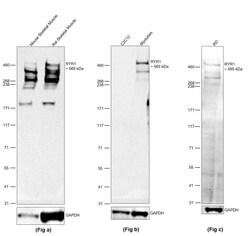
- Experimental details
- Western blot was performed using RyR1 Monoclonal Antibody (34C) (Product # MA3-925) and a 565kDa band corresponding to RYR1 was observed. In Fig a, Western blot analysis was performed using tissue extracts (30 µg lysate) of Mouse Skeletal Muscle (Lane 1) and Rat Skeletal Muscle (Lane 2). In Fig b, Western blot analysis was performed using whole cell extracts (30 µg lysate) of C2C12 (Lane 1), C2C12 differentiated to myotubes (Lane 2) and whole cell extracts (30 µg lysate) of RD was used for Fig c. The extracts were electrophoresed using NuPAGE™ 3-8% Tris-Acetate Protein Gel (Product # EA0378BOX), 10 well. Resolved proteins were then transferred onto a nitrocellulose membrane (Product # IB23001) by iBlot® 2 Dry Blotting System (Product # IB21001). The blot was probed with the primary antibody (1:5000) and detected by chemiluminescence with Goat anti-Mouse IgG (H+L) Superclonal™ Recombinant Secondary Antibody, HRP (Product # A28177, 1:20,000) using the iBright™ FL1500 Imaging System (Product # A44115). Chemiluminescent detection was performed using SuperSignal™ West Pico PLUS Chemiluminescent Substrate (Product # 34580) for Fig a and SuperSignal™ West Atto Ultimate Sensitivity Substrate (Product # A38556) was used for Fig b and Fig c. Upregulation of RyR1 upon differentiation of C2C12 cells to Myotubes is observed in Fig b.
Supportive validation
- Submitted by
- Invitrogen Antibodies (provider)
- Main image
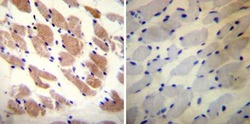
- Experimental details
- Immunohistochemistry was performed on biopsies of deparaffinized Human skeletal muscle tissue. To expose target proteins, heat induced antigen retrieval was performed using 10mM sodium citrate (pH6.0) buffer, microwaved for 8-15 minutes. Following antigen retrieval tissues were blocked in 3% BSA-PBS for 30 minutes at room temperature. Tissues were then probed at a dilution of 1:20 with a mouse monoclonal antibody recognizing Ryanodine Receptor (Product # MA3-925) or without primary antibody (negative control) overnight at 4°C in a humidified chamber. Tissues were washed extensively with PBST and endogenous peroxidase activity was quenched with a peroxidase suppressor. Detection was performed using a biotin-conjugated secondary antibody and SA-HRP, followed by colorimetric detection using DAB. Tissues were counterstained with hematoxylin and prepped for mounting.
Supportive validation
- Submitted by
- Invitrogen Antibodies (provider)
- Main image
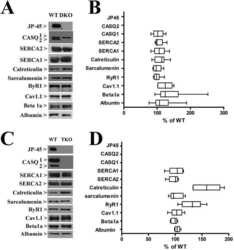
- Experimental details
- NULL
- Submitted by
- Invitrogen Antibodies (provider)
- Main image
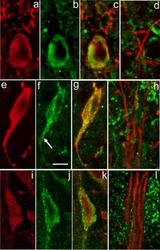
- Experimental details
- NULL
- Submitted by
- Invitrogen Antibodies (provider)
- Main image
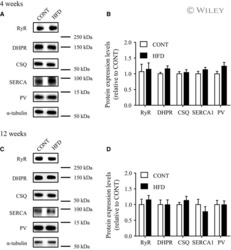
- Experimental details
- NULL
- Submitted by
- Invitrogen Antibodies (provider)
- Main image
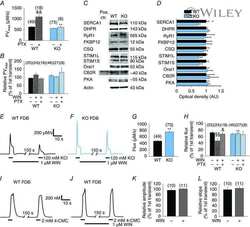
- Experimental details
- NULL
- Submitted by
- Invitrogen Antibodies (provider)
- Main image
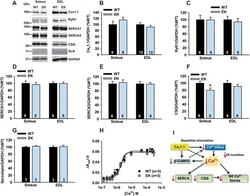
- Experimental details
- Figure 3 Ca 2+ handling proteins. (A) Representative western blot images of Ca V 1.1, RyR1, SERCA1, SERCA2, calsequestrin (1 and 2), and sarcolipin. To allow the use of data in multiple western blots each band within a single western blot was normalized to GAPDH for that sample as a loading control and then normalized to the average WT values for that particular gel to give %WT. (B) Analysis of muscle levels of Ca V 1.1 normalized to GAPDH. (C) Analysis of muscle levels of RyR1 normalized to GAPDH. (D) Analysis of muscle levels of SERCA1 normalized to GAPDH. (E) Analysis of muscle levels of SERCA2 normalized to GAPDH. (F) Analysis of muscle levels of CSQ normalized to GAPDH. (G) Analysis of sarcolipin normalized to GAPDH. (H) SERCA activity as a function of Ca 2+ concentration. (I) Scheme of changes in Ca 2+ handling proteins. Values are shown as mean +- SEM. * P
- Submitted by
- Invitrogen Antibodies (provider)
- Main image
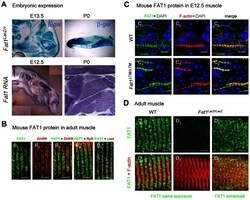
- Experimental details
- Figure 7 Fat1 expression at late stages of muscle differentiation. ( A ) Fat1 expression was visualized in E13.5 embryos or in neonate (P0) muscle by beta-galactosidase staining or by in situ hybridization with a Fat1 3'UTR RNA probe. ( B - D ) Immunolocalization of FAT1 (anti-FAT1-ICD from [35] , green) was performed in E12.5 mouse embryo ( C ), and on adult ( B, D ) muscle fibers on longitudinal muscle cryosections from wild type ( B , C 1-3 , D 1,4 ), from Fat1 DeltaTM/DeltaTM embryos ( C 4-6 ), and from Fat1 LacZ/LacZ ( D 2-3 , D 5-6 ) mice, combined with either antibodies against alpha-actinin (red, B 5 ), DHPR (Cacna1s) (red, B 2,3 ), or RyR (red, B 4 ), or with Phalloidin (red, C, D ). In D , Green channel images (FAT1) were first captured with either identical exposure time between wild type and mutants ( D 1,4 and D 2,5 , 421 ms), or with longer exposure time ( D 3,6 , 2222 ms). This indicates that the epitope detected by the anti-FAT1-ICD antibody (from ref [35] ) is present in reduced but detectable amounts in Fat1 LacZ/LacZ muscles. This observation was made when Fat1 LacZ/LacZ mice (n = 2 at P0; and n = 3 at adult stages) displayed severe muscle defects at the stage of dissection, indicating that levels of FAT1 protein inversely correlate with phenotype severity. Scale bars: ( B - D ) 4 um, ( C ) 6 um.
- Submitted by
- Invitrogen Antibodies (provider)
- Main image
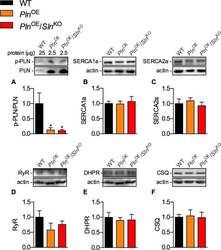
- Experimental details
- Fig 2 PLN phosphorylation and expression levels of other Ca 2+ regulatory proteins. (A) Western blot analyses demonstrating that monomeric p-PLN/PLN ratio is significantly lower in both Pln OE and Pln OE / Sln KO soleus muscles compared with WT (n = 5-6 per genotype). Western blotting for other major Ca 2+ regulatory proteins SERCA1a (B, 110 kDa), SERCA2a (C, 110 kDa), RyR (D, 565 kDa), DHPR (E, 170 kDa), and CSQ (F, 63 kDa) did not reveal any significant differences across genotypes (n = 5-8 per genotype, with a 6 mug load for all proteins). *Significantly different from WT using a a one-way ANOVA with a Tukey's post-hoc, p
- Submitted by
- Invitrogen Antibodies (provider)
- Main image
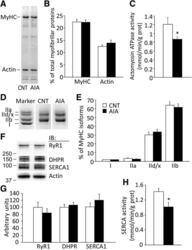
- Experimental details
- Fig. 1 Actomyosin ATPase and sarcoplasmic reticulum (SR) Ca 2+ -ATPase activities are decreased in AIA EDL muscles. Representative Coomassie brilliant blue staining of myofibrillar proteins ( a ), percentage distribution of myosin heavy chain (MyHC) and actin content in total myofibrillar proteins ( b ), and actomyosin ATPase activity ( c ). Electrophoretically separated MyHC isoforms ( d ) and percentage distribution of MyHC isoforms ( e ): I, slow isoform and IIa, IId/x, and IIb, fast isoforms. Representative Western blots of ryanodine receptor (RyR1), dihydropyridine receptor alpha2 subunit (DHPR), and SR Ca 2+ -ATPase (SERCA) 1 ( f ), the expression levels of these proteins normalized to actin content ( g ), and SERCA activity ( h ). Control (CNT), white bars ; AIA, black bars . Data are presented as mean +- SEM for three to seven muscles in each group. * P < 0.05 versus CNT
- Submitted by
- Invitrogen Antibodies (provider)
- Main image
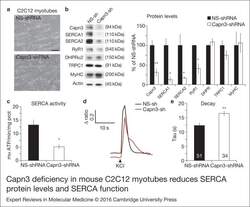
- Experimental details
- Figure 1. Capn3 deficiency in mouse C2C12 myotubes reduces SERCA protein levels and SERCAfunction. (a) C2C12 myotubes treated with NS or Capn3 shRNAs and differentiated for7 days. Scale bar = 100 mum (b) Western blot analysis showing significant decreaseof Capn3 (SPA antibody), SERCA1, SERCA2 and RyR1 levels in Capn3 knockdown myotubes,compared with controls (* P < 0.05;** P < 0.01). Total levels of DHPR, TRPC1, MyHC and actin arenot significantly changed. N = 3 independent experiments run on thesame gel. (c) SERCA-specific ATPase activity determined in homogenates from C2C12myotubes. Capn3-deficient myotubes show a significant reduction of SERCA activitycompared with NS-controls ( n = 3,* P < 0.05). (d and e) Ca 2+ imaging of C2C12myotubes loaded with Fura2-AM shows delayed Ca 2+ clearance from thecytosol in Capn3 knockdown myotubes. (d) Two representative traces of changes inFura2-AM fluorescence ratios( F 340 / F 380 ) fromCapn3-shRNA and NS-shRNA treated myotubes. Ca 2+ transients were elicitedby local stimulation with KCl 50 m m in the absence of extracellularCa 2+ . (e) Tau, the time constant of the Ca 2+ transient decayphase in seconds (s), is significantly increased in Capn3-deficient myotubes.** P < 0.01, n = total number of myotubesrecorded from six different experiments are shown in the graph.
- Submitted by
- Invitrogen Antibodies (provider)
- Main image
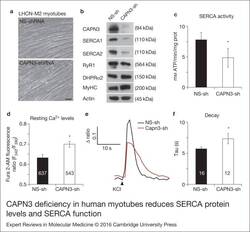
- Experimental details
- Figure 2. CAPN3 deficiency in human myotubes reduces SERCA protein levels and SERCA function.(a) LHCN-M2 myoblasts treated with control NS-shRNA or CAPN3-shRNAs anddifferentiated for 9 days. Scale bar = 50 mum. (b) Representative Western blotanalysis showing decrease of CAPN3 (12A2 mAb), SERCA1, SERCA2 and RyR1 proteinlevels in CAPN3-sh treated myotubes compared with controls. DHPRalpha2, MyHC and actinlevels remain unaltered. (c) SERCA-specific ATPase activity determined inhomogenates from LHCN-M2 myotubes. CAPN3-deficient myotubes show a significantreduction of SERCA activity compared with NS-controls ( n = 3,* P < 0.05). D-F) Ca 2+ imaging of LHCN-M2myotubes loaded with Fura2-AM shows increased cytosolic [Ca 2+ ] anddelayed Ca 2+ clearance from the cytosol in CAPN3 knockdown myotubes. (d)Resting cytosolic [Ca 2+ ] was measured in the presence of 2 m m Ca 2+ at 37degC. CAPN3-deficient human myotubes show significantlyincreased resting cytosolic [Ca 2+ ] compared with controls(* P < 0.05; n = 10 experiments). Totalnumbers of myotubes recorded are shown in the graph. (e) Two representative tracesof changes in Fura2-AM fluorescence ratios( F 340 / F 380 ) fromCAPN3-shRNA and NS-shRNA treated myotubes. Ca 2+ transients were elicitedby local stimulation with KCl 130 m m in the absence of extracellularCa 2+ . (f) Tau, the time constant of the Ca 2+ transient decayphase in seconds (s), is significantly increased in CAPN3-deficient myotubes.* P < 0.05, n = total number of myotubesr
- Submitted by
- Invitrogen Antibodies (provider)
- Main image
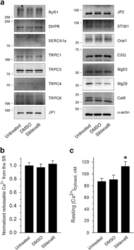
- Experimental details
- Figure 5 Expression level of skeletal muscle proteins, the amount of releasable Ca 2+ from the SR to the cytosol, and the resting cytosolic Ca 2+ level in primary skeletal myotubes. ( a ) The immunoblot analysis of proteins mediating Ca 2+ movements and handling in skeletal muscle was conducted using the lysate of myotubes treated with sildenafil. Fifteen proteins were examined, and no expression levels were changed by sildenafil (the expression level of proteins is presented as bar graphs in Supplementary Figure 5 ). alpha-Actin was used as a loading control. At least three independent experiments per protein were conducted and a representative result is presented. JP, junctophilin; CSQ, calsequestrin; Mg, mitsugumin; CaM, calmodulin. The amount of releasable Ca 2+ from the SR to the cytosol in response to TG (2.5 mu M ) ( b ) or resting cytosolic Ca 2+ level ( c ) was examined in myotubes treated with sildenafil, and histograms are shown for the normalized peak amplitude or area under the peak to the mean value of those from untreated controls as described in the 'Materials and methods' section. TG was applied to myotubes in the absence of extracellular Ca 2+ to avoid extracellular Ca 2+ entry. The results are presented as the means+-s.e. for the number of experiments presented in the parentheses of Table 2 . *, and the significant difference was compared with the untreated control ( P
- Submitted by
- Invitrogen Antibodies (provider)
- Main image
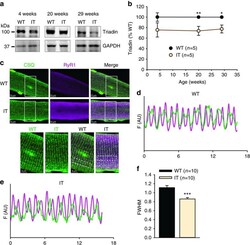
- Experimental details
- Figure 3 Effect of the IT mutation on triadin and CSQ. ( a ) Representative western blots of triadin levels in soleus muscle from WT and IT mice at different ages. ( b ) Analysis of triadin levels. ( c ) RyR1 and CSQ localization in FDB fibres by immunocytochemistry. Magenta: RyR1, Green: CSQ. ( d , e ) Line scans of CSQ and RyR1 immunostaining in FDB fibres of IT ( e ) and WT ( d ) mice. ( f ) Analysis of the fluorescence profile of CSQ in WT and IT fibres, FWHM is full width at half maximum. Data are shown as mean+-s.e.m. * P
- Submitted by
- Invitrogen Antibodies (provider)
- Main image
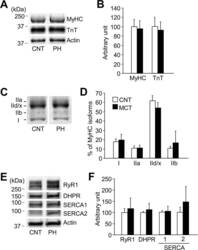
- Experimental details
- Fig 2 Neither contractile proteins nor excitation-contraction coupling proteins are altered in PH diaphragm muscles. A : Stain free images of myosin heavy chain (MyHC) and western blots of troponin (Tn) T. B : the expression levels of MyHC or TnT normalized to actin content. C : electrophoretically separated MyHC isoforms. D : percentage distribution of MyHC isoforms: I, slow myosin isoform; IIa, IId/x, and IIb, fast myosin isoforms. E : representative western blots of ryanodine receptor (RyR1), dihydropyridine receptor alpha2 subunit (DHPR), sarcoplasmic reticulum Ca 2+ -ATPase (SERCA) 1, and SERCA2. F : the expression levels of RyR1, DHPR, SERCA1, or SERCA2 normalized to actin content. Control (CNT), white bars; AIA, black bars. Data represent mean +- SD for 4-8 rats in each group.
 Explore
Explore Validate
Validate Learn
Learn Western blot
Western blot Immunoprecipitation
Immunoprecipitation